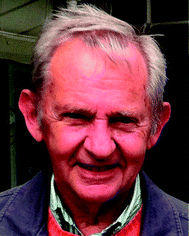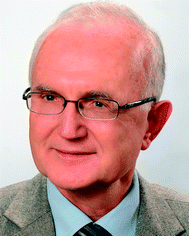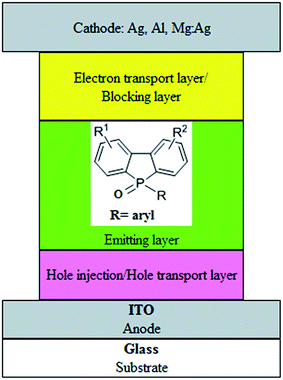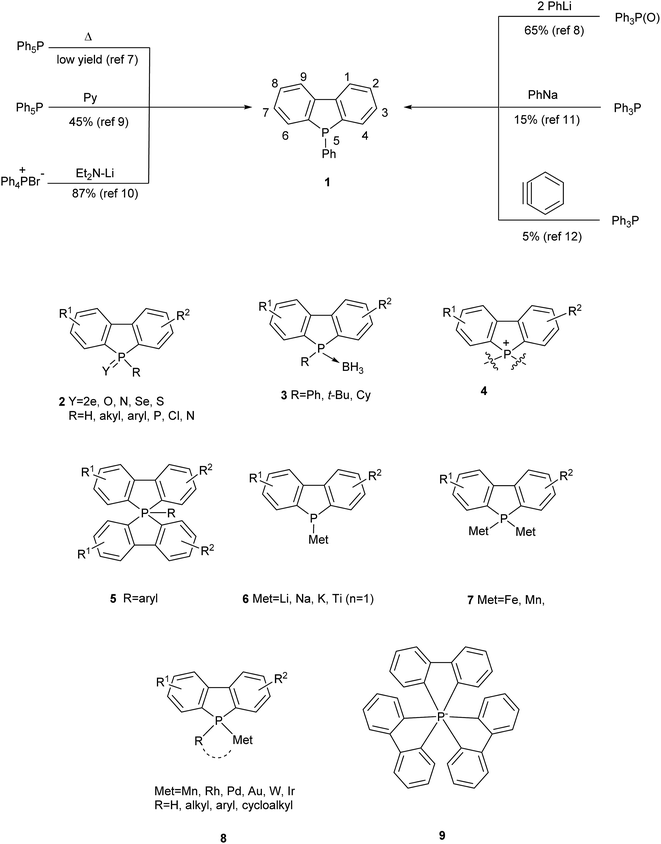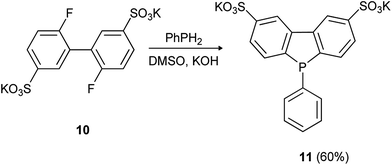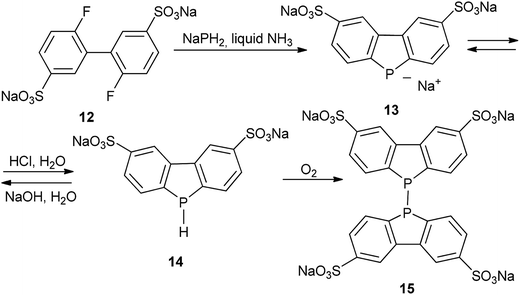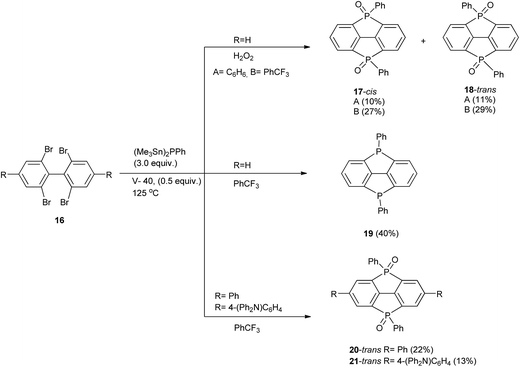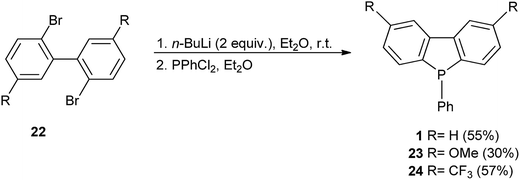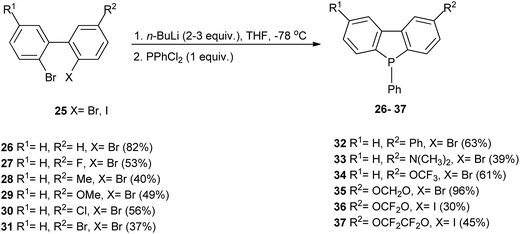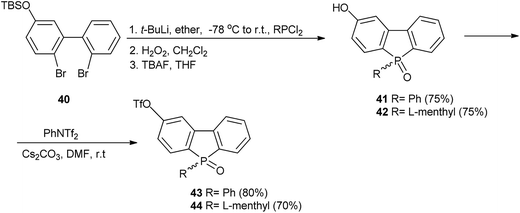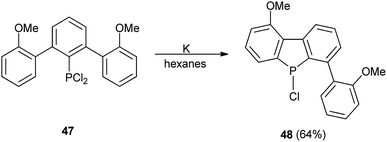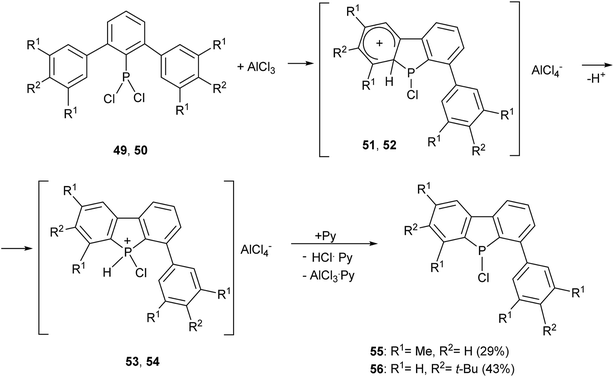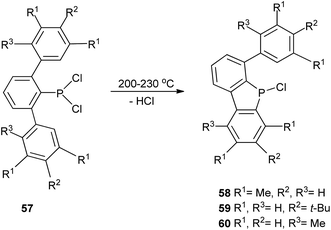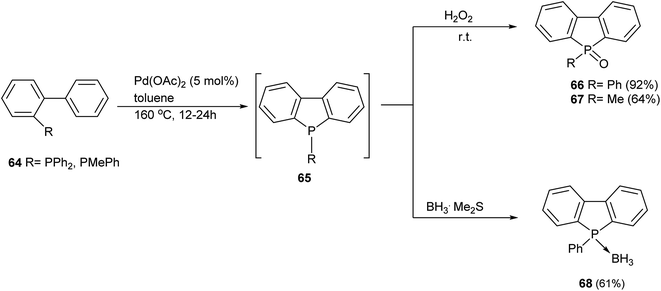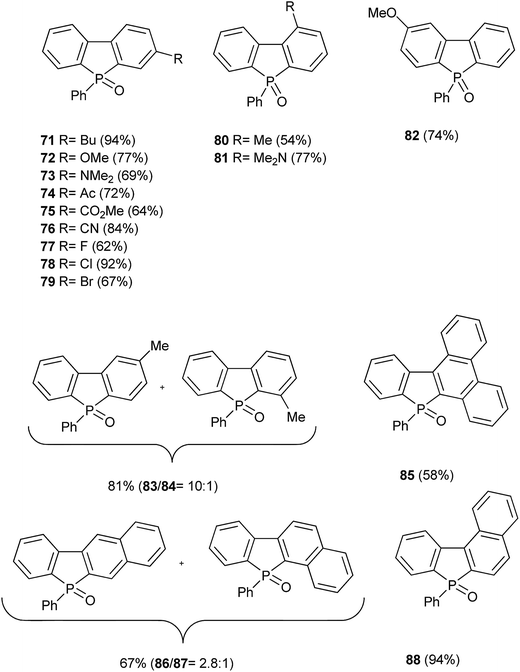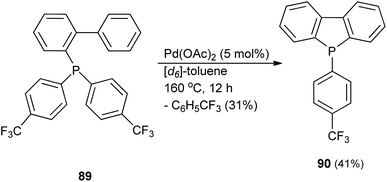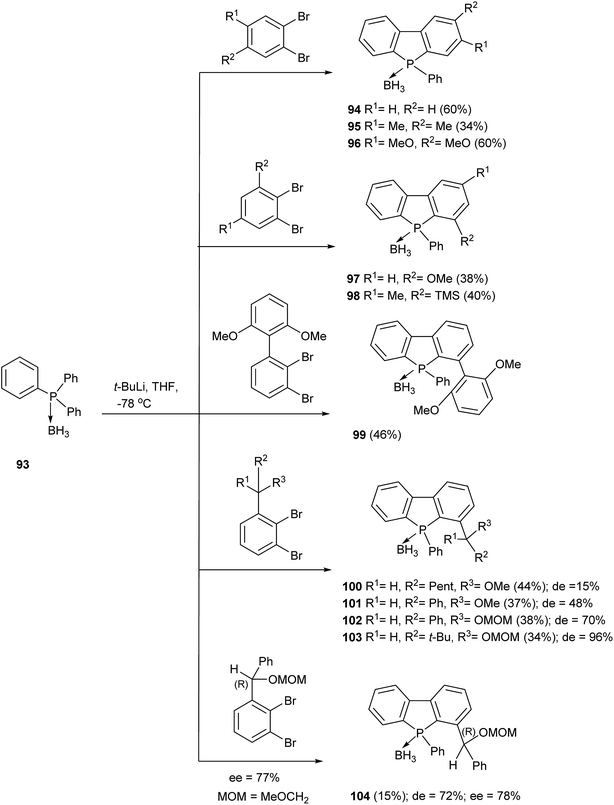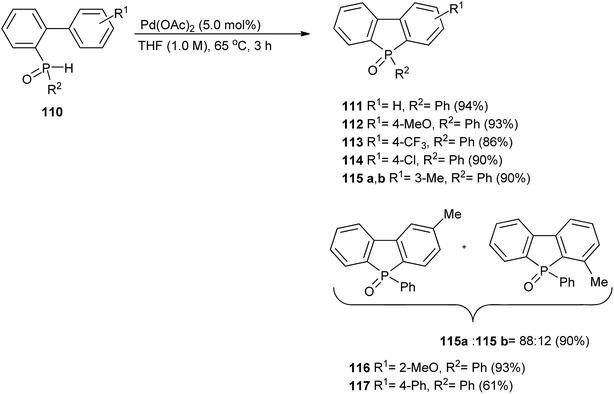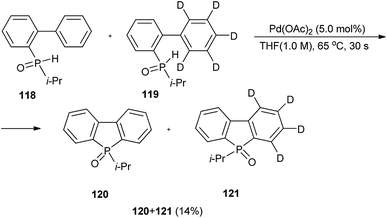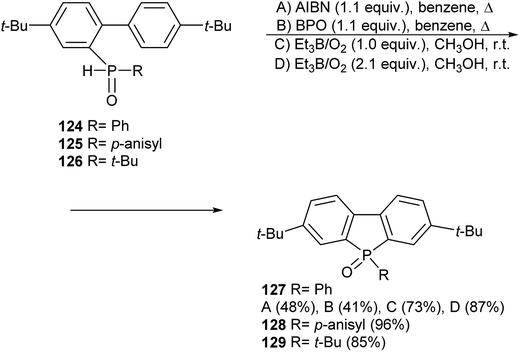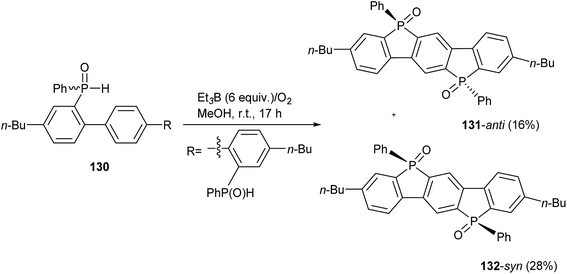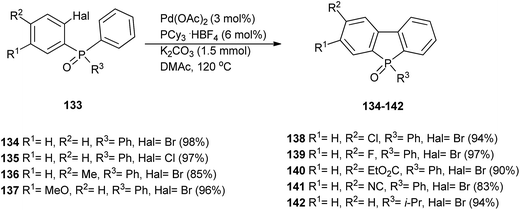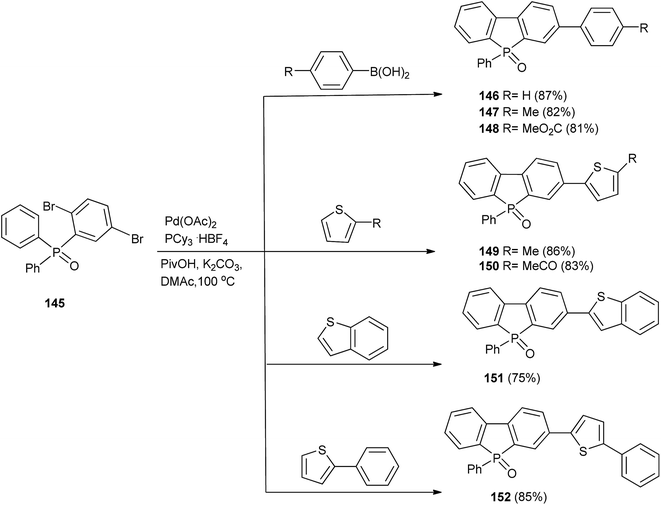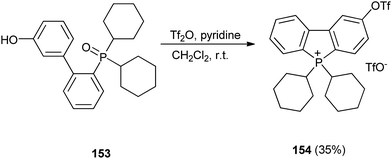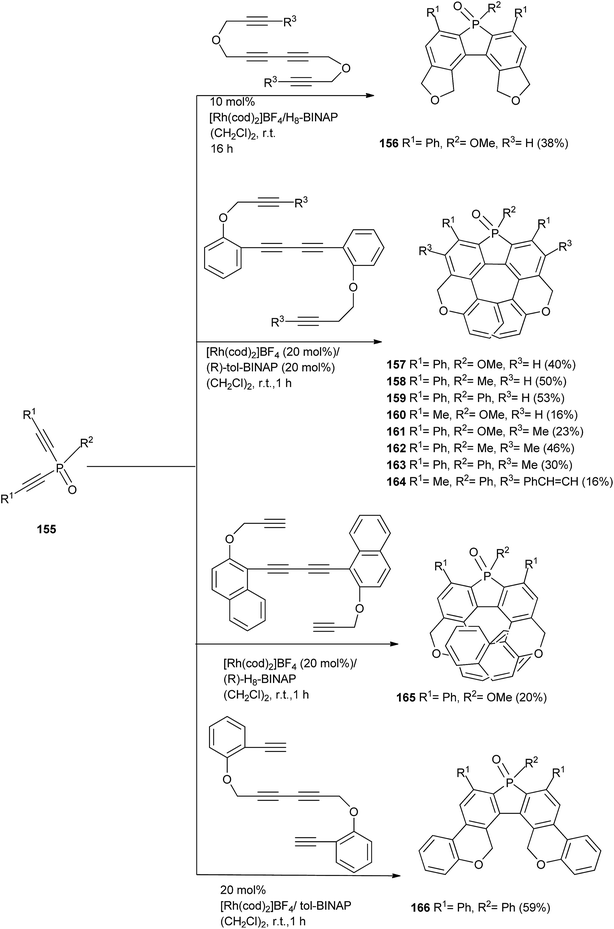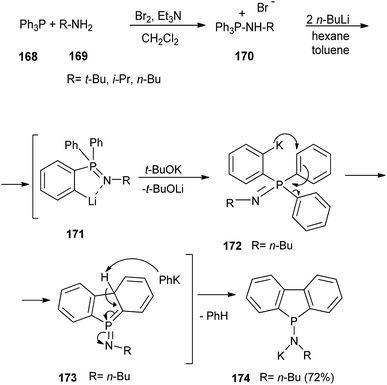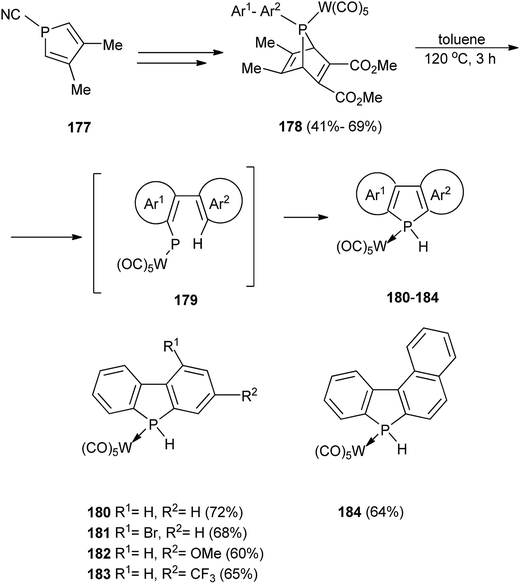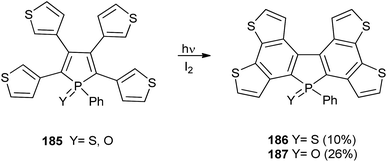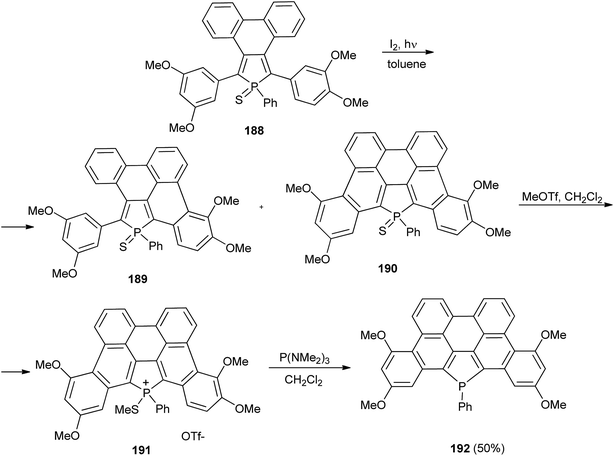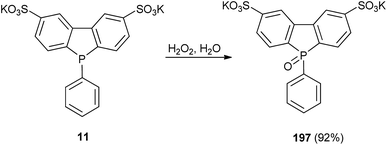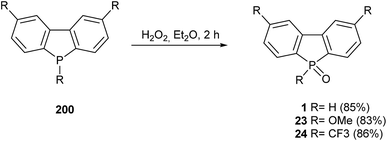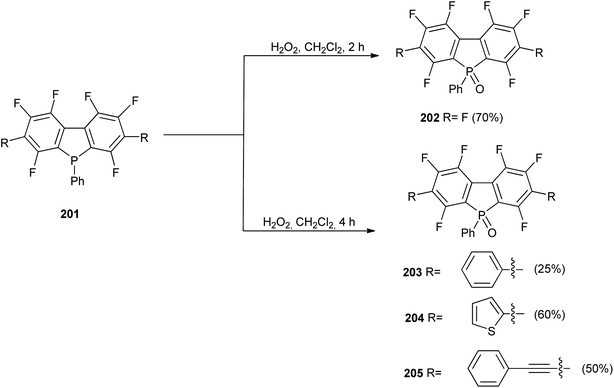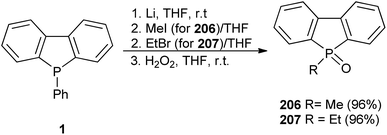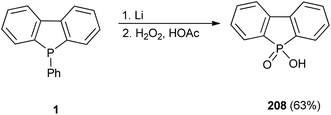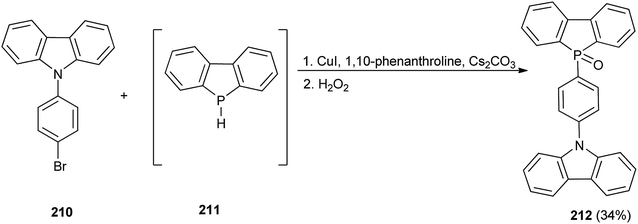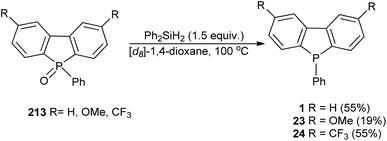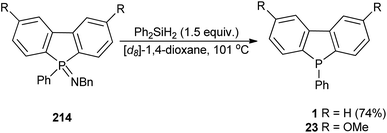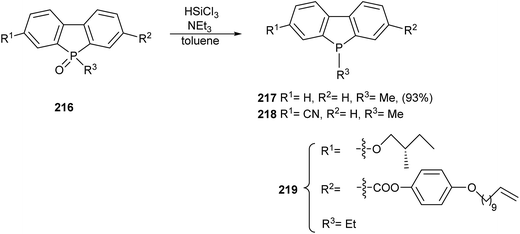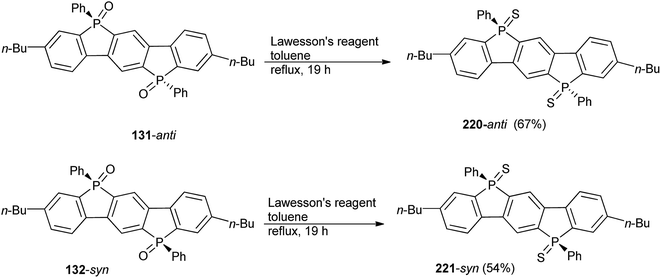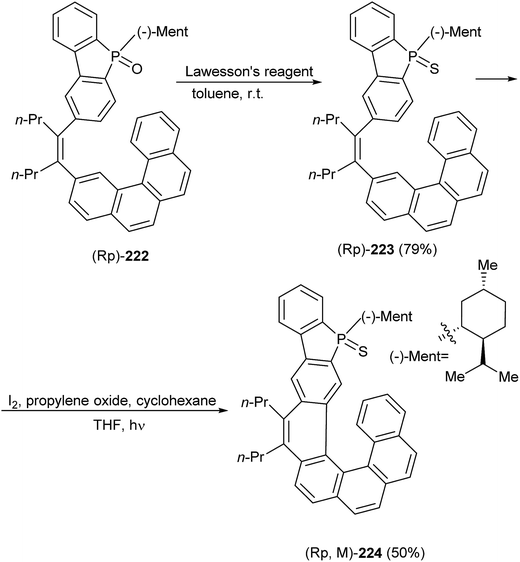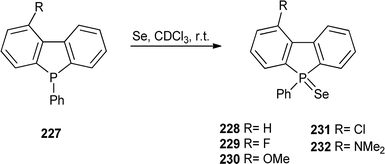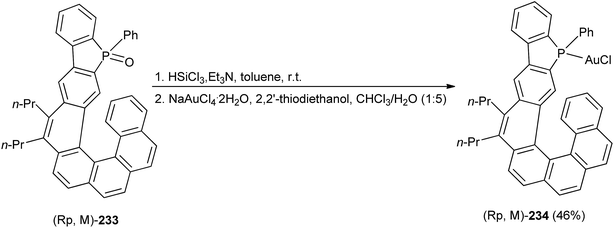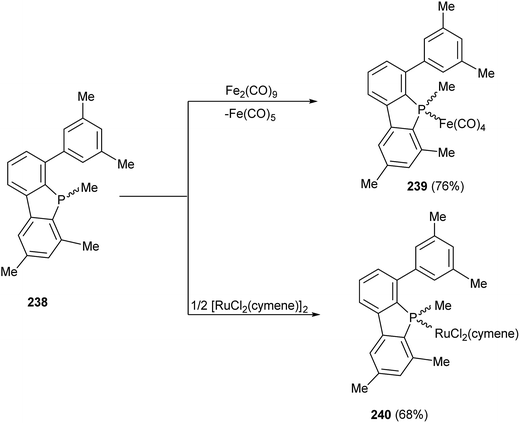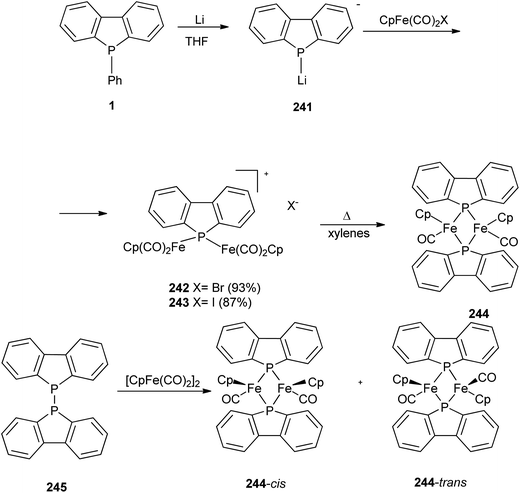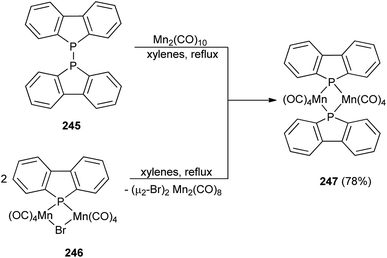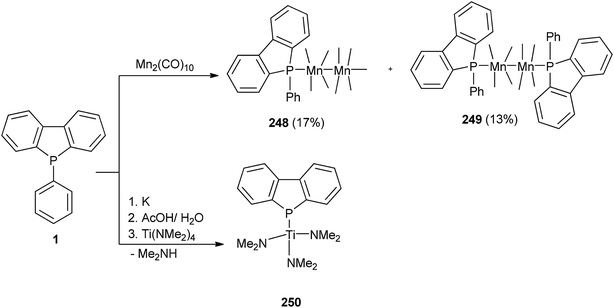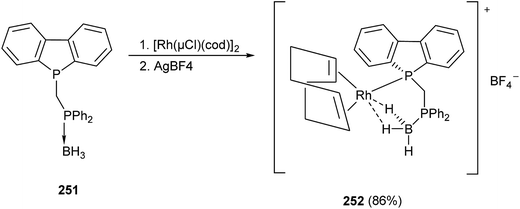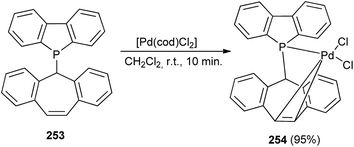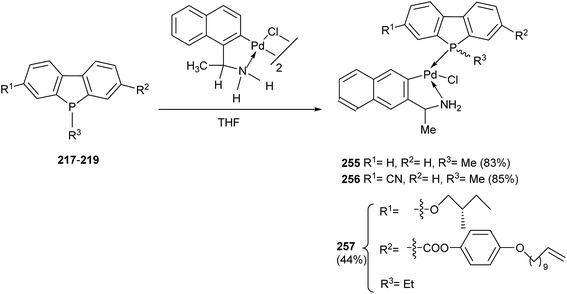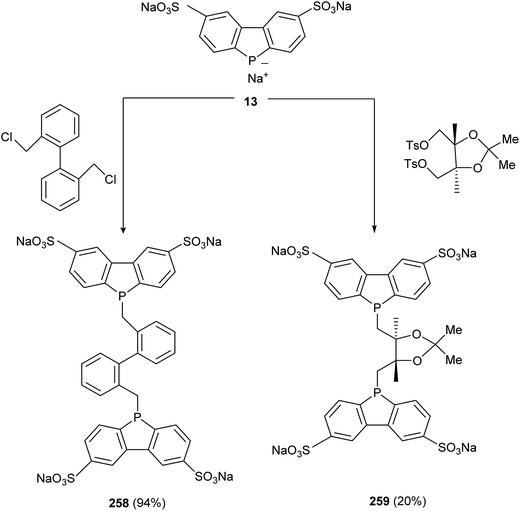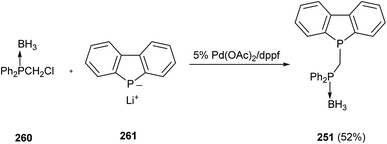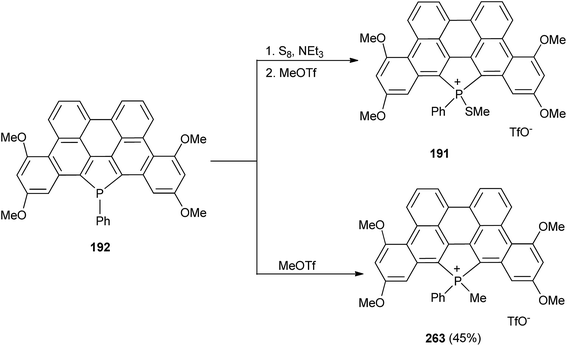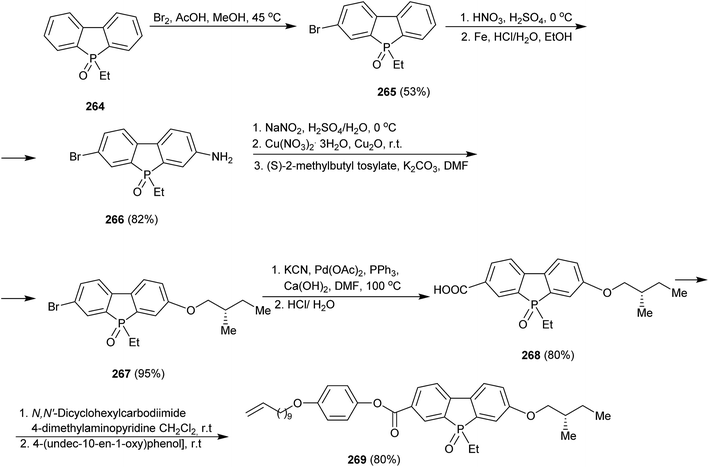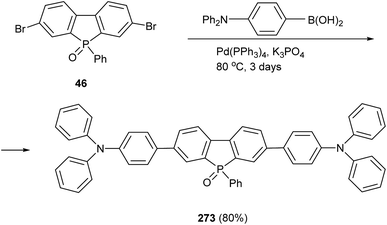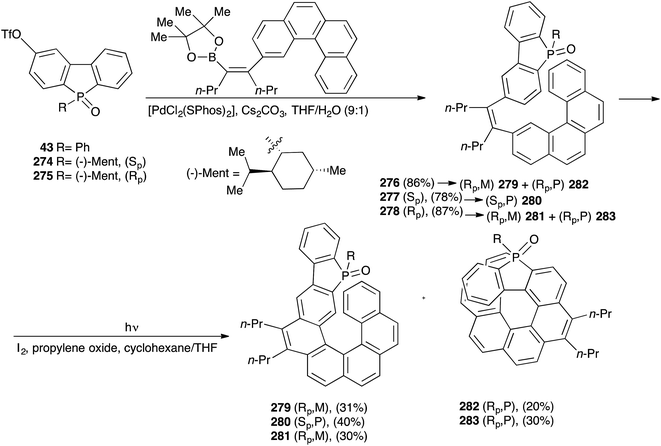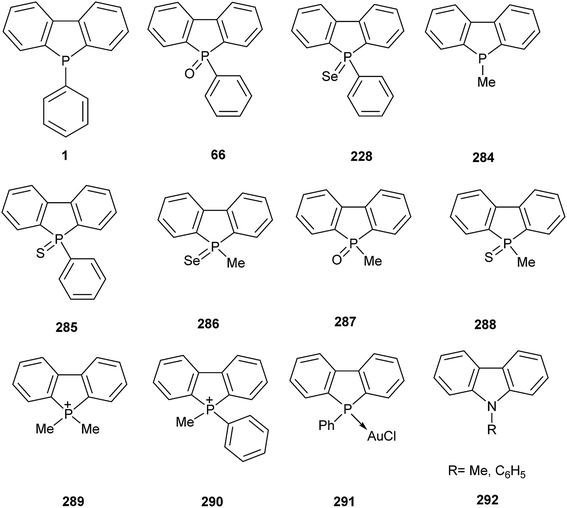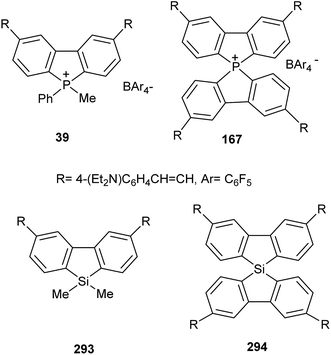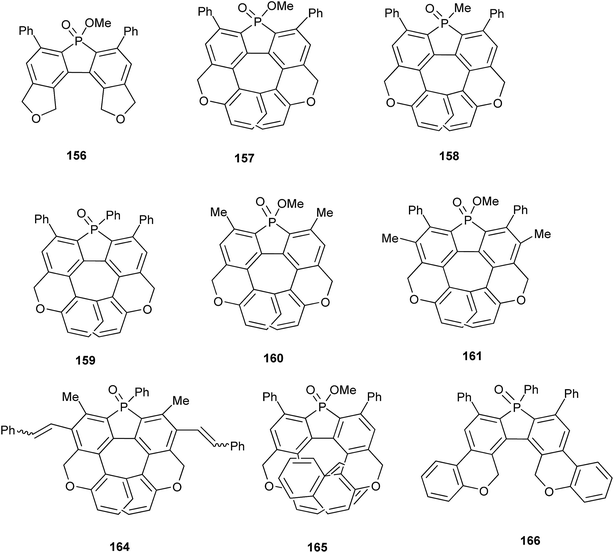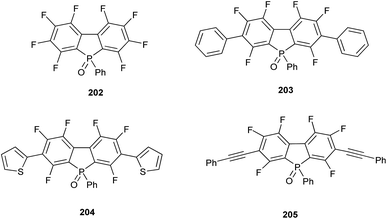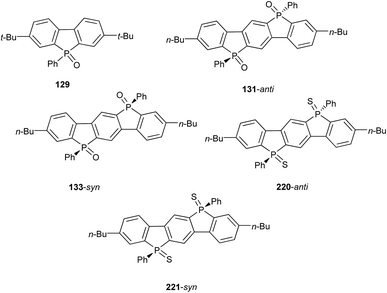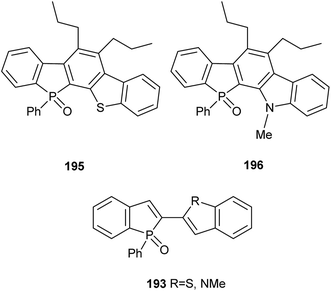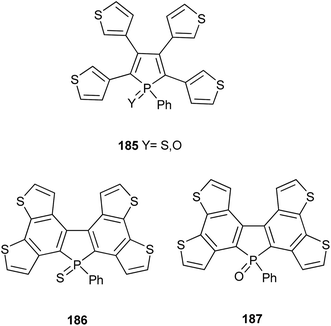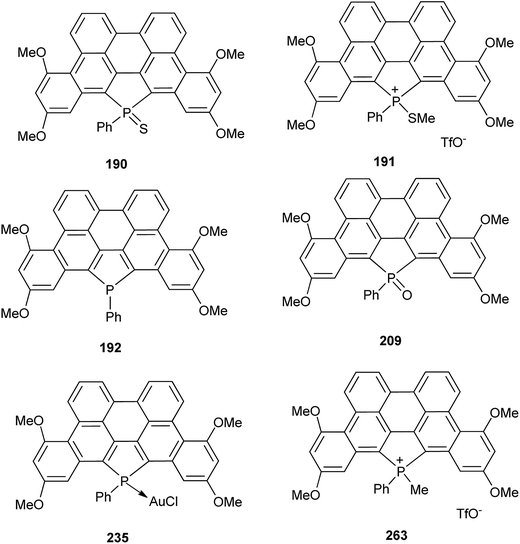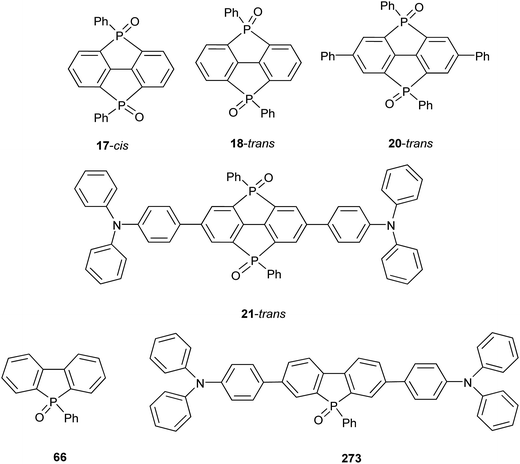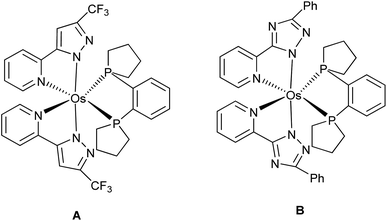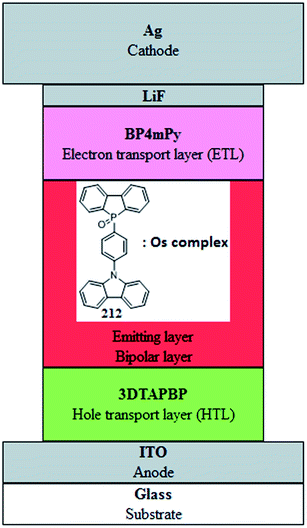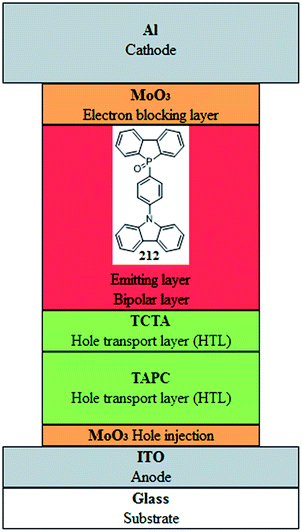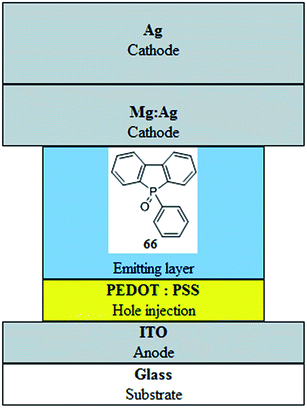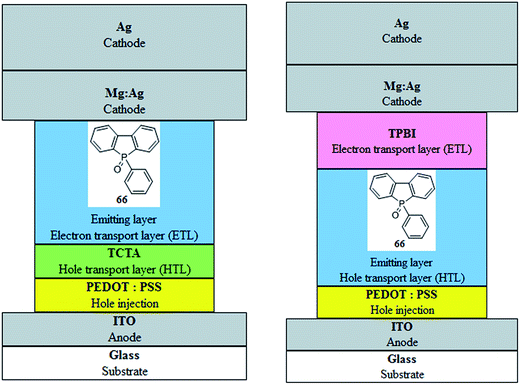 Open Access Article
Open Access ArticleCreative Commons Attribution 3.0 Unported Licence
Recent studies of the synthesis, functionalization, optoelectronic properties and applications of dibenzophospholes
Paulina Hibner-Kulicka
ab,
John Arthur Joule
c,
Joanna Skalik
a and
Piotr Bałczewski
 *ad
*ad
aDepartment of Heteroorganic Chemistry, Centre of Molecular and Macromolecular Studies, Polish Academy of Sciences, Sienkiewicza 112, 90-363 Łódź, Poland. E-mail: pbalczew@cbmm.lodz.pl; Fax: +48 42 684 71 26; Tel: +48 42 684 71 26
bDepartment of Molecular Physics, Technical University of Łódź, Żeromskiego 116, 90-924 Łódź, Poland. Fax: +48 42 631 32 18; Tel: +48 42 631 32 05
cThe School of Chemistry, The University of Manchester, Manchester M13 9PL, UK
dJan Długosz University in Częstochowa, Institute of Chemistry, Environmental Protection and Biotechnology, The Faculty of Mathematics and Natural Sciences, Armii Krajowej 13/15, 42-201 Częstochowa, Poland. Tel: +48 34 378 41 00
First published on 30th January 2017
Abstract
The first dibenzophospholes were described in the 1950s, but only recently have they gained greater importance, due to their use in organic electronics and the possibility of designing new π-conjugated, optoelectronic materials that incorporate these heterocycles. Our comprehensive review covering a period of 15 years (2001–2016), includes methods of synthesis of these compounds, methods for their functionalization, a description of their optoelectronic properties and their first use in optoelectronic devices. The review represents the current state of knowledge in this field and shows the great potential of simple and functionalized dibenzophospholes. The work described in this review suggests that dibenzophospholes should also be investigated more intensively as single materials, as well as in structural combinations with other π-extended conjugated aromatic and heteroaromatic systems containing phosphorus, nitrogen, silicon or sulfur atoms.
1. Introduction
Interest in π-conjugated compounds has increased greatly following the investigations of Heeger, MacDiarmid and Shirakawa,1 that led to the award of the Chemistry Nobel Prize in 2000. There followed a period of dynamic development in the field of synthesis and studies on the properties of oligomeric and polymeric systems applicable to flexible, lightweight and low-cost electronic devices. A great deal of attention has been paid not only to structural modifications, but also to supramolecular organization of such compounds to achieve optimal properties of the final materials. The use of conjugated polyaromatic, polyacetylenic, polyolefinic compounds and fused aromatic systems, as well as their structural combinations, not only guarantees satisfactory properties and excellent stability of these compounds, but also the possibility for their easy chemical functionalization using modern synthetic tools. A disadvantage of the systems containing aromatic building blocks has often been a too high degree of aromaticity, which inhibits an easy electron delocalization along the conjugated rings when in an oxidized state.2–4Therefore, this type of molecular system requires a beneficial incorporation of heteroaromatic rings, for example five-membered pyrrole, thiophene or furan, possessing lower aromatic stabilization energies (ASEcalc: 20.57, 18.57, 14.77 kcal mol−1, respectively) than a benzene ring. The aromatic character of the phosphole ring (ASEcalc = 3.2 kcal mol−1) is relatively low due to the pyramidal geometry of the phosphorus atom. Overlap between the lone pair and the diene unit is thus limited, resulting in a lower aromatic character compared with other five-membered heterocycles with nitrogen, sulfur or oxygen. The low aromatic character allows hyperconjugation of the endocyclic 4-π-electron system with the exocyclic P–R bond. Closely related dibenzophospholes I (Scheme 1) and their derivatives, being further examples of such fused heterocyclic systems, have been used successfully, alone or as building blocks, for preparation of more complex π-conjugated systems useful as electronic and optoelectronic materials. However, they are still an underestimated group of compounds in this field.
Dibenzophospholes I together with dibenzofurans II, dibenzothiophenes III and carbazoles IV belong formally to a family of heteroanalogs of fluorene V, or to be more precise, the fluorene anion (Scheme 1).
Important reviews by Réau,5 Baumgartner6,7 and Hissler8,9 serve as brief introductions to phospholes and other organophosphorus derivatives in the molecular electronics context. Hissler's reviews focus mainly on nonfused phospholes and diheteroaromatic derivatives of phospholes fused to thiophene, pyrrole, furan, pyridine moieties and other P-derivatives with a particular emphasis on incorporation into electronic devices while the (micro)reviews by Réau and Baumgartner focus on development of phosphole-containing oligo- and polythiophene materials. A 2015 review by Gouygou10 discussed phosphole-based ligands, including dibenzophospholes, which have potential in metal and organocatalysed reactions.10
In our comprehensive review, we summarise the literature on the newest methods of synthesis and functionalisation of the dibenzophospholes as well as their applications as optoelectronic materials (Fig. 1). This work continues the comprehensive coverage in a previous review devoted to synthesis of dibenzophospholes by Aitken in 200111 and thus it deals with work from the years 2001–2016.
Although the first dibenzophospholes were described in the 1950s, in recent times, these interesting compounds have gained importance due to the possibility of using them in new π-conjugated materials. The presence of the two flanking benzene rings in a dibenzophosphole gives the system several advantages over monocyclic phospholes in the context of incorporation into molecular electronics roles. The synthesis and synthetic manipulation of the tricyclic system allows adjustment of overall electronic structure by the introduction and manipulation of benzene-ring substituents. In particular, the linking of dibenzophosphole units to other electronically active components or its incorporation into polymer chains is facilitated by the benzene-ring units.
An important advantage of dibenzophospholes is their high resistance to thermal decomposition. For example, the temperature of thermal decomposition for dibenzophosphole is 365 °C, while for the phospholes and dithienophospholes thermal decomposition temperatures are between 200 and 300 °C.12
Dibenzophospholes and analogous tricyclic, dithienophospholes, are each well delocalized over the entire molecule and possess a smaller HOMO–LUMO gap than any of the component rings. Consequently the dibenzophospholes represent an independent class of compounds and should not be considered as classic, monocyclic phospholes. The dithienophosphole system, developed by Baumgartner et al.,13–18 also possesses some advantages with respect to wavelength, intensity, especially tunability, as well as optical and thermal stability.
In this context, dibenzophospholes can be regarded as complementary optoelectronic materials and it is interesting to make a comparison of some selected properties of non-fused phospholes, fused dibenzophospholes and dithienophospholes, such as ranges of light absorption and light emission maxima, and luminescence quantum efficiencies. Thus for phospholes, the data are 350–450 nm, 450–620 nm, up to 0.143, for dibenzophospholes the significantly different values are 290–365 nm, 360–490 nm, up to 0.98, and for dithienophospholes the values are 330–420 nm, 415–630 nm, up to 0.90.17,18
The first described dibenzophosphole (IUPAC, CAS: 5H-benzo[b]phosphindole]) was 5-phenyl substituted derivative 1,19 obtained by Wittig in 1953, in low yield from a thermal decomposition of pentaphenylphosphorane Ph5P. Other early methods, most of which were also elaborated by Wittig and coworkers, involved reactions of Ph5P, Ph3P, and Ph4P+X− (X = Cl, Br), Ph3P(O), with both weak (Py) and strong bases (PhMet, Et2NMet; Met = Li, Na)20–23 as well as the reaction of Ph3P with benzyne (Scheme 2).24
The phosphorus atom in dibenzophospholes offers the possibility of expanding its valency and forming new bonds to O, S, Se, B, N, P, Cl, C and metals in derivatives 2, 3 and 6–8. Dibenzophospholes possessing ionic structures, like the cation 4 and the anion 9 are also known. The phosphorane structure 5 containing two dibenzophosphole units was reported for the first time by Hellwinkel in 1960.25
2. Synthesis of dibenzophospholes
2.1. From PH3 and derivatives
In the years 2001–2015, new methods of synthesis of dibenzophospholes have been elaborated starting from PH3 and its derivatives. Stelzer, Sheldrick et al. obtained 5-phenyl-2,2′-bis(sulfonato)-5H-dibenzophosphole dipotassium salt 11 by reaction of primary phenylphosphine with 5,5′-bis(sulfonato)-2,2′-difluoro-1,1′-biphenyl dipotassium salt 10 in superbasic medium DMSO/KOH in 60% yield (Scheme 3).26This research group also obtained the P-unsubstituted dibenzophosphole 14 by reaction of 5,5′-bis(sulfonato)-2,2′-difluoro-1,1′-biphenyl disodium salt 12 with NaPH2 in liquid ammonia. In this reaction, the trisodium salt 13 was formed first, which upon acidification with aqueous HCl under aerobic conditions gave the dibenzophosphole disalt 14 accompanied by its dimer 15 (Scheme 4).26
Various bridged dibenzophospholes 17–21 have been obtained by a radical phosphanylation. An example of this approach is the reaction of tetrabromobiphenyls 16 (R = H, Ph) with (Me3Sn)2PPh in benzene or trifluoromethylbenzene, in the presence of V-40 (1,1′-azobis(cyclohexane-1-carbonitrile)) as a radical initiator followed by a subsequent oxidation of the corresponding intermediate with H2O2. In this process, two cis/trans isomers 17 and 18 were formed in a ratio of 1.0![[thin space (1/6-em)]](https://www.rsc.org/images/entities/char_2009.gif) :
:![[thin space (1/6-em)]](https://www.rsc.org/images/entities/char_2009.gif) 1.1 in 10% and 11% yields, in benzene and in the same ratio in 27% and 29% yields in trifluoromethylbenzene, respectively. Interestingly, the dibenzophosphole 19 precipitated pure, in 40% yield, by stirring the crude reaction mixture at room temperature overnight. The radical phosphanylation of the biphenyl 16 (R = aryl) led to formation of 4,4′-diaryl-substituted bis(phosphoryl)-bridged biphenyls 20 and 21 in 22% and 13% yields, respectively (Scheme 5).27
1.1 in 10% and 11% yields, in benzene and in the same ratio in 27% and 29% yields in trifluoromethylbenzene, respectively. Interestingly, the dibenzophosphole 19 precipitated pure, in 40% yield, by stirring the crude reaction mixture at room temperature overnight. The radical phosphanylation of the biphenyl 16 (R = aryl) led to formation of 4,4′-diaryl-substituted bis(phosphoryl)-bridged biphenyls 20 and 21 in 22% and 13% yields, respectively (Scheme 5).27
Zhou and Breit et al. obtained 3,7-di-tert-butyl substituted dibenzophospholes functionalized at the phosphorus atom by pyridin-2-(1H)-on-6-yl, 6-pivalamidopyridin-2-yl and isoquinolin-1(2H)-on-3-yl moieties starting from 2,2′-dibromo-4,4′-di-tert-butylbiphenyl.28
Gaunt, Girolami and Kozimor et al. described the reaction of PCl3 with 2,2′-dibromo-1,1′-biphenyl that unexpectedly gave a mixture of 5-chloro- and 5-bromo-5H-dibenzophospholes in a 3![[thin space (1/6-em)]](https://www.rsc.org/images/entities/char_2009.gif) :
:![[thin space (1/6-em)]](https://www.rsc.org/images/entities/char_2009.gif) 2 ratio as a result of halogen exchange. Both 5-halodibenzophospholes after separation behaved similarly in the subsequent conversion into a new family of dibenzophosphole-based dithiophosphinic acids using elemental sulfur and sodium hydrosulfide hydrate.29
2 ratio as a result of halogen exchange. Both 5-halodibenzophospholes after separation behaved similarly in the subsequent conversion into a new family of dibenzophosphole-based dithiophosphinic acids using elemental sulfur and sodium hydrosulfide hydrate.29
2.2. From ArPCl2, Ar2PCl or RPCl2
Due to easy access to chlorophosphines, the synthesis of dibenzophospholes involving dilithiobiaryls constitutes a convenient source of these compounds. Using this method, Delft et al. obtained symmetrical dibenzophospholes 1, 23 and 24 from the corresponding 2,2′-dibromobiphenyl precursors bearing H, MeO or CF3 groups by generation of the corresponding dianion with n-BuLi in Et2O at room temperature followed by quenching the reaction mixture with dichlorophenylphosphine to give 5-phenyldibenzophosphole 1, 2,8-dimethoxy-5-phenyldibenzophosphole 23 and 2,8-bis(trifluoromethyl)-5-phenyl-dibenzophosphole 24 in 55%, 30% and 57% yields, respectively (Scheme 6).30Gouygou, Leroux et al. obtained symmetrical and unsymmetrical dibenzophospholes 26–37 in 30–96% yields starting from 2,2′-dihalobiaryls via double halogen/lithium exchange with n-BuLi in THF at −78 °C followed by trapping the resulting dilithium derivatives with dichlorophenylphosphine (Scheme 7).31
The phosphoniafluorene 39 has been obtained according to the above procedure by dilithiation of the 5,5′-disubstituted 2,2′-dibromo-1,1′-biphenyl 38 followed by condensation of the resulting dilithio derivative with dichlorophenylphosphine PhPCl2 and then quaternization of the dibenzophosphole phosphorus atom with MeI in THF. After exchange of the iodide ion to the BAr4 anion, compound 39 was obtained as a red solid in 57% yield (Scheme 8).32
This method was also used for the preparation of 2-hydroxy-substituted dibenzophosphole oxides 41–44. After bromine/lithium exchange on the dibromobiphenyl derivative 40, the dilithiated intermediate was treated with either PhPCl2 or (L-menthyl)PCl2. Then, the dibenzophospholes were oxidized in situ with H2O2 and the tert-butyldimethylsilyl (TBS) group was removed by reaction with tetra-n-butylammonium fluoride (TBAF) to give oxides 41 and 42 in 75% yields. The hydroxy groups in the latter were converted into the corresponding triflates 43 and 44 by treatment with PhNTf2. For R = L-menthyl, the dibenzophosphole oxide 42 was obtained as a mixture of two epimers with opposite configuration at the stereogenic phosphorus center. The mixture was converted into triflates 44 and the two diastereomers were separated by HPLC (Scheme 9).33
t-Butyllithium in THF, at −90 °C was also used for iodine/lithium exchange in 45 followed by reaction with PhPCl2 and oxidation with H2O2 to give 3,7-dibromo-5-phenyl dibenzophosphole oxide 46 in 47% yield (Scheme 10).27
Another method, described by Ionkin and Marshall in 2003, involved the reaction of the dichloroarylphosphine 47 with potassium in hexanes to give the 5-chlorodibenzophosphole derivative 48 in 64% yield (Scheme 11).34
In 2006, Wehmschulte et al. described the intramolecular Friedel–Crafts type reaction of the dichlorophosphines 49 or 50 initiated by AlCl3 in [d6]-benzene at room temperature. In this reaction dibenzophospholes 55 and 56 were formed in 29% and 43% yields, respectively, via intermediates 51/52 and 53/54, as yellow-orange oils, which were decomposed to the final products by addition of pyridine (Py) (Scheme 12).35
The same research group synthesised 5-chloro disubstituted dibenzophospholes 58–60 via thermolysis of the aryldichlorophosphine 57 at 200–230 °C with HCl evolution (Scheme 13).35
2.3. From RAr2P or Ar3P
5-Phenyldibenzophosphole 1 has also been obtained in a two-step reaction involving addition of 1-lithio-2-diphenylphosphinylbenzene 61 to benzyne 62 followed by cyclisation of the resulting lithio adduct 63. The starting materials 61 and 62 were obtained from 2-bromophenyl-diphenyl phosphine and 1,2-dibromobenzene, respectively (Scheme 14).36The next method, published by Tobisu, Chatani et al. in 2013, involves intramolecular cyclisation of biphenyl derivatives 64 containing PPh2 and PMePh groups in the presence of catalytic amounts of Pd(OAc)2 (5 mol%) in toluene through the cleavage of the C–H bond and exclusive cleavage of the P–Ph bond rather than the P–Me one. The dibenzophospholes formed first in these reactions were easily oxidized with hydrogen peroxide at room temperature which led to dibenzophosphole oxides 66 and 67 in 92%, 64% yields, respectively or reacted with borane dimethylsulfide to give the dibenzophosphole borane 68 in 61% yield (Scheme 15).37
The same reaction, carried out with 1 equivalent of Pd(OAc)2 (in air), gave 66 in 50% yield, suggesting that the dimeric metallacycle 70 (X-ray analysis) was a plausible intermediate for the catalytic cycle. Dibenzophospholes bearing a range of functional groups (Br, F, CO2Me, Ac, CN) and an array of fused rings (naphthalene, anthracene, furan, pyrrole) could also be synthesised using this method (Scheme 16).37
The route was also successfully applied to the synthesis of a diverse array of dibenzophospholes 71–88. The high functional group tolerance allowed access to a range of electronically different dibenzophospholes bearing alkyl 71, 80, 83/84, ether 72, alkoxyl 82, amine 73 and 81, acyl 74, ester 75, nitrile 76, fluoride 77, chloride 78, and bromide 79 groups. The C–P bond formation also took place with substrates bearing ortho substituents to afford 1-substituted dibenzophospholes 80 and 81. Substrates with meta substituents underwent a regioselective cyclisation at the less hindered site to form 83 as a major product. This synthesis enabled various π systems including naphthalene and phenanthrene moieties, to be incorporated into the dibenzophosphole core of the compounds 85–88 (Scheme 17).37
In a special case, this method could also be applied to the synthesis of 5-P-aryl substituted dibenzophosphole 90 bearing an electron-withdrawing p-trifluoromethyl on the aryl group, by cyclisation of bis(trifluoromethylphenyl)-o-(1,1′-biphenyl)phosphine 89 in the presence of Pd(OAc)2, in [d6]-toluene, the final dibenzophosphole 90 being obtained in 41% yield (Scheme 18).37
In the phosphine 91, carrying one CF3C6H4 group and one phenyl, a mixture of dibenzophosphole oxides 66 and 92 was obtained upon oxidation with H2O2, indicating a preference of the P–CF3C6H4 bond cleavage over the unactivated P–C6H5 unit (Scheme 19).37
Another modification of this approach involved the synthesis of the starting phosphine via the Suzuki–Miyaura cross-coupling of o-bromophenyldiphenylphosphine with 2,4-dimethoxyphenylboronic acid, followed by cyclisation in situ, without isolation, to give the final dibenzophosphole oxide.37
Satoh and Miura et al. described the transformation of phenylphosphinothioic amides into fused dibenzophosphole derivatives through rhodium-catalyzed coupling with heterobicyclic alkenes and intramolecular phospha-Friedel–Crafts reactions in a one-pot manner.38
2.4. From Ar3P–BH3
Jugé, Leroux, Colobert et al. reported the first chemo-, regio-, and diastereoselective syntheses of P-chirogenic dibenzophosphole boranes 94–104 based on a transition metal-free, aryne cross-coupling methodology. Most of the reactions started from the tertiary phosphine-borane 93 and a variety of o-dibromobenzenes to simultaneously create an aryl–aryl bond and the five-membered ring of the dibenzophosphole moiety in 15–60% yields (Scheme 20).36The use of P-modified boranes 105 in which R3 or R4 = Ph has been replaced by tert-butyl (t-Bu), cyclohexyl (Cy) or ortho-anisyl (o-An) (2-MeOC6H4) groups did not improve yields of these reactions (27–44%). Interestingly, in the case of 105 (R3 = Ph, R4 = o-An), preferential P-o-An cleavage occurred to give 109 (R3 = Ph) in 44% yield (Scheme 21).36
2.5. From Ar2P(O)H or Ar(R)P(O)H
Aryl or alkyl biphenyl hydrophosphine oxides have been applied successfully to the synthesis of 5-aryl and 5-alkyl substituted dibenzophosphole oxides. Thus, starting from secondary hydrophosphine oxides 110, Kuninobu et al. obtained 5-aryl substituted dibenzophospholes 111–117 via phosphine–hydrogen and carbon–hydrogen bond cleavages in the presence of a catalytic amount of palladium(II) acetate (Scheme 22). This process was also carried out with [2-(2-naphthyl)phenyl]phenylphosphine oxide as a substrate to give the corresponding dibenzophosphole in 92% yield.39The same methodology was applied to the synthesis of a mixture of 5-i-Pr substituted dibenzophospholes 120 and 121. These compounds were obtained in a ratio of 70![[thin space (1/6-em)]](https://www.rsc.org/images/entities/char_2009.gif) :
:![[thin space (1/6-em)]](https://www.rsc.org/images/entities/char_2009.gif) 30, respectively, starting from a mixture of nondeuterated and deuterated phosphine oxides 118 and 119 in the ratio 1
30, respectively, starting from a mixture of nondeuterated and deuterated phosphine oxides 118 and 119 in the ratio 1![[thin space (1/6-em)]](https://www.rsc.org/images/entities/char_2009.gif) :
:![[thin space (1/6-em)]](https://www.rsc.org/images/entities/char_2009.gif) 1. Based on these results, it could be assumed that the C–H bond activation of one of the aromatic rings was the rate-determining step (Scheme 23).39
1. Based on these results, it could be assumed that the C–H bond activation of one of the aromatic rings was the rate-determining step (Scheme 23).39
Terphenyl bis(hydrophosphine oxide) 122 was also applied in the same manner by Kuninobu et al. for the synthesis of a polycyclic, conjugated bis(dibenzophosphole oxide) 123 in 87% yield (Scheme 24).39
Dibenzophospholes were also obtained by the intramolecular radical cyclisation of 2-biphenylaryl and biphenylalkylphosphine oxides 124–126 in the presence of various initiators: 2,2′-azobis-isobutyronitrile (AIBN), benzoyl peroxide (BPO) or Et3B/O2 under different reaction conditions. In the case of the phosphine oxide 124 (R = Ph), the use of typical initiators, such as AIBN and BPO in refluxing benzene, gave the corresponding products 127 in 48% and 41%, according to procedures A and B, respectively. Performing the reaction under milder conditions by using triethylborane and oxygen as a radical initiator gave 127 in higher yields of 73% and 87%, respectively (procedures C and D). These reaction conditions were applicable to other substrates 125 and 126 bearing p-anisyl and tert-butyl groups on the phosphorus atom, respectively to give the corresponding products 128 and 129 in good 96% and 85% yields, respectively (Scheme 25).40
This radical methodology has also been applied to the synthesis of bis(dibenzophosphole oxides) having spatially extended systems of π-conjugated bonds, by using a double, intramolecular radical cyclisation of the phosphine oxide 130 in the presence of Et3B/O2, in MeOH. The products of this reaction were two diastereoisomeric bis(dibenzophosphole oxides): 131-anti and 132-syn obtained in 16% and 28% yields, respectively (Scheme 26).40
2.6. From Ar3P(O) or ArR2P(O)
In this subsection, the syntheses of dibenzophospholes that are described start from phosphine oxides containing at least one aryl group. In 2014, Cui, Jiang et al. developed a new method for the synthesis of dibenzophosphole oxides 134–142 from the readily available ortho-halodiarylphosphine oxides 133 by use of Pd(OAc)2 as a catalyst complexed with PCy3 leading to intramolecular palladium-catalysed arylation (Scheme 27).41An intramolecular double arylation catalysed by Pd(OAc)2 was applied to the synthesis of polycyclic dibenzophosphole oxide 144 starting from the dibromo derivative 143 in 82% yield (Scheme 28).41
Another intramolecular version of the double arylation was realised by the same research group starting from diaryl-2,5-dibromophosphine oxide 145 and arylboronic acids or heteroarenes. Here, the phosphine complexed Pd(OAc)2 as a catalyst brought about the intramolecular arylation and, in the same pot, afforded further functionalised dibenzophosphole oxides 146–152 in 75–87% yields by a Suzuki–Miyaura cross-coupling (146–148) or direct cross-coupling with a heteroarene (149–152) (Scheme 29).41
Ishikawa and Manabe obtained the dibenzophosphole 154 in 35% yield by an intramolecular heteroaromatic electrophilic substitution reaction of the phosphine oxide 153 in the presence of triflic anhydride Tf2O in pyridine. In this reaction, the oxygen atom of the phosphoryl group first reacted with triflic anhydride Tf2O to generate an electrophilic intermediate and this was followed by electrophilic aromatic ring closure enhanced by the electron-releasing hydroxyl group; final OH/OTf conversion afforded 154 in 35% yield (Scheme 30).42
Stankevič et al. synthesised a new group of bulky 5-tert-butyldibenzophosphole 5-oxides from acyclic diaryl-tert-butylphosphine oxides and organolithiums.43
Other syntheses of dibenzophospholes starting from phosphine oxides of type ArR2P(O) and R3P(O) are described in the subsection 2.7.
2.7. From R2P(O)CH3 or R2P(O)OCH3
Tanaka et al. synthesized enantioenriched benzopyrano- or naphthopyrano-fused helical dibenzophosphole oxides 156, 157, 160, 161, 165 by the rhodium-catalyzed, enantioselective, double [2+2+2] cycloaddition of methyl dialkynylphophinates 155 (R2 = OMe) with phenol or naphthol-linked tetraynes in 16–40% yields. In a similar way, dialkynyl methyl and phenyl phosphine oxides 155 (R2 = Me, Ph) were employed to afford 158, 159, 162, 163, 164 and 165 in 30–59% yields (Scheme 31).44Synthesis of dibenzophospholes from aryl substituted phosphine oxides Ar3P(O) and ArR2P(O) has been described in the previous subsection 2.6.
2.8. From (RO)3P(O)
Only one synthesis of dibenzophospholes has been reported starting from organic phosphates. The spirobiphosphoniafluorene 167 was obtained by the reaction of the dilithio derivative, obtained from the 2,2′-dibromo-1,1′-biphenyl 38, with triphenyl phosphate followed by I/BAr4 counterion exchange, in 32% yield (Scheme 32).322.9. From Ar3P![[double bond, length as m-dash]](https://www.rsc.org/images/entities/h3_char_e001.gif) N–R
N–R
Synthesis of dibenzophospholes utilizing organophosphorus reagents containing a P![[double bond, length as m-dash]](https://www.rsc.org/images/entities/char_e001.gif) Y bond, where Y is a heteroatom (Y = N, P) other than oxygen, sulfur or selenium are also rare transformations. Nief et al. obtained dibenzophospholes by transmetalation of the intramolecularly stabilized lithium derivative 171 to give the potassium salt 172, followed by intramolecular nucleophilic attack of the latter on the phenyl ring to form the intermediate 173. Further aromatization by deprotonation with PhK produced the potassium salt of the 5-amino-dibenzophosphole 174 (R = n-Bu) as a white, insoluble solid. The starting lithium derivative 171 was obtained via NH and CH deprotonation of the phosphonium bromide 170 followed by ortho-lithiation of one of the phenyl rings with n-butyllithium in toluene/hexane. The phosphonium bromides 170 were synthesized from triphenylphosphine 168 and primary alkyl amines (R = t-Bu, i-Pr, n-Bu) (Scheme 33).45
Y bond, where Y is a heteroatom (Y = N, P) other than oxygen, sulfur or selenium are also rare transformations. Nief et al. obtained dibenzophospholes by transmetalation of the intramolecularly stabilized lithium derivative 171 to give the potassium salt 172, followed by intramolecular nucleophilic attack of the latter on the phenyl ring to form the intermediate 173. Further aromatization by deprotonation with PhK produced the potassium salt of the 5-amino-dibenzophosphole 174 (R = n-Bu) as a white, insoluble solid. The starting lithium derivative 171 was obtained via NH and CH deprotonation of the phosphonium bromide 170 followed by ortho-lithiation of one of the phenyl rings with n-butyllithium in toluene/hexane. The phosphonium bromides 170 were synthesized from triphenylphosphine 168 and primary alkyl amines (R = t-Bu, i-Pr, n-Bu) (Scheme 33).45
2.10. From ArP![[double bond, length as m-dash]](https://www.rsc.org/images/entities/h3_char_e001.gif) PMe3
PMe3
Simpson, Protasiewicz et al. obtained a sterically hindered dibenzophosphole 176 by photolysis of the phosphorane derivative 175 in 90% yield (Scheme 34).46
2.11. From phospholes and benzophospholes
An interesting synthesis of dibenzophospholes and their heteroaromatic analogs, in which one benzene moiety was replaced by thiophene, furan, pyrrole or indole, was presented by Mathey et al. using a classical 7-phosphanonorbornadiene route developed by this group. First, 3,4-dimethyl-1-cyanophosphole 177 was converted into the phospha-norbornadiene 178 in a three-step sequence involving a replacement of the CN groups by the corresponding Ar1–Ar2–Li derivative followed by metalation with W(CO)5-(MeCN) and cycloaddition of the resulting phosphole with acetylene-dicarboxylate. Next, thermolysis of 178 gave tungsten complexes of the dibenzophospholes 180–184 in 60–72% yields, as a result of insertion of the electrophilic phosphinidene intermediate 179 into a C–H bond using carbene-like chemistry (Scheme 35).47Nyulászi, Hissler, Réau et al. obtained the air-stable dibenzophosphole sulfide 186 and the dibenzophosphole oxide 187 under aerobic irradiation (320–400 nm) of dilute toluene solutions of 1-phenyl-2,3,4,5-tetra(3-thienyl)thiooxophosphole 185 (Y = S) and 1-phenyl-2,3,4,5-tetra(3-thienyl)-oxophosphole 185 (Y = O) containing a catalytic amount of iodine, in 10% and 26% yields, respectively (Scheme 36).48
The photocyclisation of 188, using the Katz-modified approach, gave a mixture of the monocyclised derivative 189 and the fully cyclised target dibenzophosphapentaphene 190, in 50% and 20% yields, respectively after separation. Then, treatment of 190 with methyl triflate afforded the phospholium salt 191 in 60% yield. The final phosphapentaphene 192 was obtained by desulfurisation of the latter with P(NMe2)3, in 50% yield (Scheme 37).49
Another method, reported by Matano et al. is the cycloaddition of alkynes to biaryls containing a benzophosphole unit, catalysed by palladium(II) acetate, in the presence of pivalic acid (PivOH) and Bu4NBr. The examples of this method are with compounds 193 (Y = S, NMe) and 4-octyne, in which the authors obtained polycyclic aromatic compounds 195 and 196 containing dibenzophosphole oxide and dibenzothiophene or carbazole units in 14% and 53% yields, respectively (Scheme 38).44
3. Functionalisation of dibenzophospholes
Dibenzophospholes can be functionalised at the phosphorus atom and on the two peripheral benzene rings. The functionalisation can be achieved during synthesis of the dibenzophosphole rings or as a result of post-ring-synthesis modifications.3.1. Functionalisation at phosphorus atom
One of the most important features of the phosphole ring is a low degree of aromaticity and easy availability of a free electron pair on the phosphorus atom, which enables chemical modifications of phospholes by oxidation, sulfurization (addition of elemental sulfur), metalation or quaternization. This is due to the fact that tricoordinate phosphorus atom assumes a pyramidal geometry and the lone electron pair at the phosphorus atom has a high degree of s orbital character. These two properties limit the effective interaction between the lone electron pair and the conjugated π-electron system of the phosphole ring.Stelzer, Sheldrick et al. obtained 5-phenyl-2-2′-bis(sulfonato)-5H-dibenzophosphole-5-oxide dipotassium salt 197 directly in 92% yield by treating an aqueous solution of the salt 11 with hydrogen peroxide (Scheme 39).26
The dibenzophosphole tripotassium salt 199 was obtained by reaction of 5,5′-bis(sulfonato)-2,2′-difluoro-1,1′-biphenyl dipotassium salt 10 with PH3 using DMSO/KOtBu as a basic medium. In this reaction, the tripotassium salt 198 was formed first and next reacted with hydrogen peroxide to give 199 in 41% yield (Scheme 40).26
Other examples of the direct oxidation are reactions of substituted 5-phenyldibenzophospholes 200 with hydrogen peroxide in diethyl ether which gave the corresponding oxides 1, 23 and 24 in 85%, 83% and 86% yields, respectively (Scheme 41).51
The same reagent was employed in the synthesis of fully perfluorinated dibenzophosphole oxide 202 starting from the dibenzophosphole 201 in dichloromethane. Symmetrical diphenyl-, dithienyl- and diphenylethynyl-substituted hexafluorodibenzophosphole oxides 203–205, could also be obtained in 25%, 60% and 50% yields, respectively (Scheme 42).52
The conversion of P-phenyl into P-alkyl using 5-phenyldibenzophosphole 1 followed by P-oxidation to give the corresponding oxides has been realized by Durán et al. Thus, the reaction of 1 with lithium in tetrahydrofuran delivered a P-lithium derivative, which was first reacted with methyl iodide or ethyl bromide and then was oxidised with hydrogen peroxide. The final oxides 206 and 207 were obtained in 96% yields (Scheme 43).53
In contrast, treatment of 1 with lithium and direct oxidation of the resulting P-lithium salt with peracetic acid (H2O2/AcOH) at 45 °C led to the corresponding phosphinic acid 208 in 63% yield (Scheme 44).54
Hissler, Réau et al. oxidized the phosphorus atom in the dibenzophosphapentaphene 192, containing a fused dibenzophosphole moiety, with sodium metaperiodate (NaIO4) in dichloromethane giving the corresponding oxide 209 in 70% yield (Scheme 45).49
Chi, Chou and Chang et al. modified 5H-dibenzophosphole 211, which was synthesised in situ from 5-phenyl dibenzophosphole, by the cross-coupling reaction of the P–H bond with aryl bromide 210 in the presence of CuI as a catalyst, was followed by oxidation of the resulting intermediate with H2O2 to give 5-[4-(carbazo-9-yl)phenyl]dibenzophosphole 5-oxide 212 in 34% yield (Scheme 46).55
![[double bond, length as m-dash]](https://www.rsc.org/images/entities/b_char_e001.gif) O and P
O and P![[double bond, length as m-dash]](https://www.rsc.org/images/entities/b_char_e001.gif) N bonds. Diphenylsilane was used by Delft et al. in reduction of the P
N bonds. Diphenylsilane was used by Delft et al. in reduction of the P![[double bond, length as m-dash]](https://www.rsc.org/images/entities/char_e001.gif) O bond in dibenzophosphole oxides 213 in [d8]-1,4-dioxane, at 100 °C to give 5-phenyldibenzophosphole 1, 2,8-dimethoxy-5-phenyldibenzophosphole 23 and 5-phenyl-2,8-bis(trifluoromethyl)-dibenzophosphole 24 in 19–55% yields (Scheme 47).51
O bond in dibenzophosphole oxides 213 in [d8]-1,4-dioxane, at 100 °C to give 5-phenyldibenzophosphole 1, 2,8-dimethoxy-5-phenyldibenzophosphole 23 and 5-phenyl-2,8-bis(trifluoromethyl)-dibenzophosphole 24 in 19–55% yields (Scheme 47).51
Delft et al. also reduced dibenzophosphole iminophosphoranes 214, by means of diphenylsilane in [d8]-1,4-dioxane at 101 °C producing the corresponding dibenzophospholes 1 or 23. For the compound 23 (R = MeO), the reduction of the P![[double bond, length as m-dash]](https://www.rsc.org/images/entities/char_e001.gif) N bond was faster, than for the unsubstituted compound 1 (R = H) (Scheme 48).56
N bond was faster, than for the unsubstituted compound 1 (R = H) (Scheme 48).56
The same research group used diphenylsilane Ph2SiH2 for reduction of the water-sensitive P![[double bond, length as m-dash]](https://www.rsc.org/images/entities/char_e001.gif) N bond in the dibenzophosphole iminophosphorane 215 which was obtained in the Staudinger reaction of 1 with benzyl azide. Much faster reduction was observed with PhSiH3. Other alkyl, cycloalkyl, allyl and aryl azides were also employed in the Staudinger reaction with a catalytic amount (10% mol) of the dibenzophosphole 1. This methodology was utilised practically in the synthesis of primary amines via intermediate iminophosphoranes 215 which could be easily hydrolysed with H2O to the dibenzophosphole oxide 66 (Scheme 49).57
N bond in the dibenzophosphole iminophosphorane 215 which was obtained in the Staudinger reaction of 1 with benzyl azide. Much faster reduction was observed with PhSiH3. Other alkyl, cycloalkyl, allyl and aryl azides were also employed in the Staudinger reaction with a catalytic amount (10% mol) of the dibenzophosphole 1. This methodology was utilised practically in the synthesis of primary amines via intermediate iminophosphoranes 215 which could be easily hydrolysed with H2O to the dibenzophosphole oxide 66 (Scheme 49).57
López-Calahorra et al. used trichlorosilane in toluene to reduce dibenzophosphole oxides 216 to dibenzophospholes 217–219. The dibenzophosphole 217 was isolated as a colorless oil in 93% yield while 218 and 219 were directly converted into the corresponding cyclopalladates due to a rapid oxidation in air (Scheme 50).58
Further examples of reduction of dibenzophosphole oxides are described in subsection 3.1.5 (Schemes 57 and 59).
The dibenzophosphole sulfides 220-anti and 221-syn were prepared by conversion of the corresponding oxides 131-anti and 132-syn with Lawesson's reagent in toluene. X-ray studies confirmed two, almost flat P-terphenyl units of the ladder-type. These compounds were obtained in 67% and 54% yields, respectively (Scheme 52).40
Voituriez and Marinetti et al. obtained the phosphine sulfide 223 from the corresponding oxide 222 (Rp) by using Lawesson's reagent, in 79% yield. Photolysis of compound 223 afforded the helicene 224, with M helical configuration, as the major product in 50% yield (Scheme 53).33
A ferrocene-containing dibenzophosphole sulfide 226 was obtained in the reaction of 5-cyanophosphole 225 with t-butyllithium followed by treatment of the resulting 5-P lithium derivative with a ferrocene (FER) derivative and addition of elemental sulfur. The final product was further converted into the corresponding aldehyde which was then reduced to a primary alcohol (Scheme 54).59
Another gold chloride complex 235 was obtained in the reaction of the dibenzophosphapentaphene 192 with chloro(tetrahydrothiophene) (Tht) gold(I) in 75% yield (Scheme 57).49
The P-menthyl substituted [6]helicene (Rp,P) 236 was reduced under analogous conditions and reacted with [{Ir(cod)IrCl}2] (cod = 1,5-cyclooctadiene) to give the helicene 237 in 37% yield (Scheme 58).33
The dibenzophosphole Fe-complex 239 was obtained in the reaction of 6-substituted dibenzophosphole 238 with Fe2(CO)9 after crystallisation from benzene, in 76% yield. Analogously, the Ru-complex 240 was obtained in 68% yield after crystallization from chloroform (Scheme 59).35
In 2002, Decken et al. obtained Fe-complexes 242 and 243 from dibenzophospholyl-Li 241 and CpFe(CO)2X (X = Br, I) in THF, at room temperature, in 93% and 87% yields, respectively. Heating 242 or 243 in refluxing xylenes resulted in the formation of trace amounts of 244 as well as large amounts of intractable green solids, however, in the reaction of bis(1,1′-dibenzophospholyl) 245 and Cp2Fe2(CO)4 in refluxing xylenes a mixture of cis- and trans-isomers 244 was obtained in a 1![[thin space (1/6-em)]](https://www.rsc.org/images/entities/char_2009.gif) :
:![[thin space (1/6-em)]](https://www.rsc.org/images/entities/char_2009.gif) 15 ratio, in 75% yield (Scheme 60).60
15 ratio, in 75% yield (Scheme 60).60
The same research group obtained (μ2-dibenzophospholyl)-(μ2-bromo)-dimanganese-octacarbonyl 246 from dibenzophospholyl-Li and Mn(CO)5Br in THF in 69% yield (Scheme 61).61
The bis(μ2-dibenzophospholyl)-dimanganese-octacarbonyl 247 was obtained by heating of bis(1,1′-dibenzophospholyl) 245 and Mn2(CO)10 in refluxing xylenes in 78% yield. The same compound was formed by refluxing (μ2-dibenzophospholyl)-(μ2-bromo)-dimanganese-octacarbonyl 246 in the same solvent (Scheme 62).61
A mixture of (1-phenyldibenzophosphole)-dimanganese-nonacarbonyl 248 and di(1-phenyldibenzophosphole)-dimanganese-octacarbonyl 249 was obtained by reaction of 5-phenyldibenzophosphole 1 with dimanganese decacarbonyl in xylenes, in 17% and 13% yields, respectively. (η1-Dibenzophospholyl)tris(dimethylamido)titanium 250 was formed by a reductive cleavage of the P–Ph bond in the 5-phenyldibenzophosphole 1 using potassium followed by a subsequent acidification with acetic acid and reaction with tetrakis(dimethylamido)titanium (Ti(NMe2)4) in 41% yield (Scheme 63).53,61
Jugé and Gouygou et al. obtained the dibenzophosphole Rh-complex 252 by reaction of chloro-(1,5-cyclooctadiene)rhodium(I) with the dibenzophosphole 251 in dichloromethane, in the presence of silver tetrafluoroborate, in 86% yield (Scheme 64).62
The dibenzophosphole Pd-complex 254 was formed in the reaction of the dibenzophosphole 253, obtained from 211 and chlorodibenzotropilydene (toluene, reflux), with dichloro-(1,5-cyclooctadiene)palladium(II) (Pd(cod)Cl2) in dichloromethane, at room temperature, in 95% yield (Scheme 65).63
López-Calahorra et al. synthesized the Pd-complexes 255–257 from dibenzophospholes 217–219 and an optically active dimeric cyclopalladium compound. The reaction of the dimer with the dibenzophosphole 217 gave the complex 255. In the cases of 256 and 257, a mixture of diastereomers was separated by column chromatography followed by decoordination of the dibenzophospholes by the reaction of the pure diastereomers with 1,2-bis(diphenylphosphino)ethane and oxidation of the enantiomerically pure dibenzophospholes to their oxides using H2O2 (Scheme 66).58
The reaction of the lithium derivative 261 with (chloromethyl)phosphine borane 260, in the presence of 5% Pd(OAc)2/dppf gave 5-diphenylphosphinylmethylene dibenzophosphole borane 251 in 52% isolated yield. Direct alkylation of 261 without the presence of the Pd catalyst gave 251 in <10% yield (Scheme 68).62
3.2. Functionalisation of benzene units
The second method of functionalization of dibenzophospholes is introduction of substituents onto one or two benzene rings including functional group interconversions. An example of such a process is shown in Scheme 71. Electrophilic bromination of 5-ethyl-5H-dibenzophosphole 5-oxide 264 with bromine in acetic acid at 45 °C gave the 5-ethyl-3-bromo-5H-dibenzophosphole 5-oxide 265 in 53% yield followed by electrophilic nitration of the second benzene ring and reduction of the NO2 to NH2 group with iron under acidic conditions. Further diazotization with sodium nitrite in a cooled mixture of sulfuric acid and water led to the corresponding diazonium salt which was decomposed by addition of copper(I) oxide in the presence of copper(II) nitrate. Subsequent reaction of the phenolic OH group so formed with (S)-2-methyl tosylate in the presence of potassium carbonate gave the chiral product 267 in 95% yield. Conversion of the bromine atom to a carboxylic group was realised by a cross-coupling reaction with potassium cyanide in the presence of palladium(II) acetate followed by alkaline hydrolysis with Ca(OH)2 to give the acid 268 in 80% yield. Finally, the latter was esterified with 4-(undec-10-enoxy)phenol to give 269 also in 80% yield (Scheme 71).64Dibenzophosphole ring elongation was realised via the cross-coupling reaction of the 3-bromo dibenzophosphole 270 with (2-benzylaminophenyl)pinacolatoboron to give the biaryl derivative 271, followed by cyclisation of the latter to afford a fused polyaromatic compound 272 in 71% yield (Scheme 72).37
3,7-Bis(4-diphenylamino)phenyl substituted dibenzophosphole 273 was obtained via the double Suzuki–Miyaura cross-coupling reaction of 46 with 4-(diphenylamino)phenylboronic acid in the presence of Pd(PPh3)4 in 80% yield (Scheme 73).27
Voituriez and Marinetti et al. functionalised dibenzophosphole oxides by incorporating them into larger [6]- and [8]-helicenes. The triflates of the dibenzophosphole oxides 43, (Sp) 274 and (Rp) 275 were submitted to Suzuki cross-coupling reactions with a benzophenanthrene-substituted olefinic boronate. The coupling reactions were performed in the presence of [PdCl2(SPhos)2] (SPhos = 2-dicyclohexyl-phosphino-2′,6′-dimethoxybiphenyl) as the catalyst under standard conditions. The corresponding olefinic derivatives 276, (Sp) 277 and (Rp) 278 were obtained in high yields (78–87%). The photochemical cyclisation of compound 276 (R = Ph) in cyclohexane/THF led to the formation of a mixture of [6]- and [8]-helicenes 279 and 282, in a 7![[thin space (1/6-em)]](https://www.rsc.org/images/entities/char_2009.gif) :
:![[thin space (1/6-em)]](https://www.rsc.org/images/entities/char_2009.gif) 3 ratio, in 31% and 20% yields after purification, respectively. The cyclisation of 277 afforded a mixture of isomeric 280 from which (Sp,P) 280 was isolated in 40% yield. The oxidative photocyclisation of 278 led to a mixture of (Rp,M) 281 and (Rp,P) 283, in a 50
3 ratio, in 31% and 20% yields after purification, respectively. The cyclisation of 277 afforded a mixture of isomeric 280 from which (Sp,P) 280 was isolated in 40% yield. The oxidative photocyclisation of 278 led to a mixture of (Rp,M) 281 and (Rp,P) 283, in a 50![[thin space (1/6-em)]](https://www.rsc.org/images/entities/char_2009.gif) :
:![[thin space (1/6-em)]](https://www.rsc.org/images/entities/char_2009.gif) 42 ratio. Each isomer was isolated in 30% yield (Scheme 74).33
42 ratio. Each isomer was isolated in 30% yield (Scheme 74).33
4. Optoelectronic properties of dibenzophosphole derivatives
Dibenzophospholes and their derivatives belong to a group of polycyclic fused heteroaromatic compounds with spatially developed systems of π-type bonds, which play an important role in modern, lightweight and low-cost electronic elements such as photovoltaic cells (PV), organic light emitting diodes (OLEDs) and field effect transistors (FETs). The functionalisation of one or both benzene rings and/or derivatization of the PIII atom (as P+ or P![[double bond, length as m-dash]](https://www.rsc.org/images/entities/char_e001.gif) X, where X = N, O, P, S, Se) necessarily results in modification of physicochemical properties of the dibenzophospholes such as: solubility, HOMO/LUMO energy levels, ionization potentials, energy gap, wavelength as well as intensity of absorption and emission. By careful selection of such modifications, new optoelectronic materials with improved properties can be produced.
X, where X = N, O, P, S, Se) necessarily results in modification of physicochemical properties of the dibenzophospholes such as: solubility, HOMO/LUMO energy levels, ionization potentials, energy gap, wavelength as well as intensity of absorption and emission. By careful selection of such modifications, new optoelectronic materials with improved properties can be produced.
4.1. Non-fused dibenzophospholes
Chen and Huang et al. presented a theoretical study on the optical and electronic properties of dibenzophospholes 1, 66, 228, 284–290, involving calculations of the highest occupied molecular orbitals (HOMO), the lowest unoccupied molecular orbitals (LUMO), triplet energies (3Eg), energy gaps (Eg) as well as other calculations leading to: ionization potentials (IPs), electron affinities (EAs), including calculations of the reorganization energies (λ) and singlet exciton generation fractions (χs), together with radiative lifetimes and emission spectra. Optoelectronic properties of these compounds were compared with carbazoles 292, which are currently one of the most commonly used chemical units in optoelectronic devices. The dibenzophospholes 1, 66, 228, 284–290 had lower levels of the HOMO and LUMO than the carbazoles 292. However, the compounds 1 and 284 had a wider range of energy gaps, relative to carbazole analogues due to the nonplanar molecular structures and stronger electron-donating ability of the phosphorus atom. Chemical modifications of the PIII atom through oxidation, sulfurization and selenylation led to a gradual increase of the HOMO levels in the following order: −6.26 eV (287) < −5.83 eV (288) < −5.43 eV (286), −6.23 eV (66) < −5.86 eV (285) < −5.51 eV (228), while the LUMO decreased to around −1.55 eV, which was far below the LUMO levels of 1 and 284. This correlation showed that introduction of electron-withdrawing substituents (O, S, Se atoms) enhanced the injection and electron-transport abilities of the dibenzophospholes 66, 228, 285–286 and 288. For the ionized compounds 289 and 290 (P+Me and P+Ph), the positively charged phosphorus atom reduced the hole injection, but enhanced the electron-accepting ability of these compounds. The energy gap decreased in the following order: 4.95 (284) > 4.94 (1) > 4.80 (287) > 4.75 (66) > 4.52 (290) > 4.51 (289) > 4.33 (285) > 4.28 (288) > 3.97 (228) > 3.88 eV (286). The triplet energies (3Eg) of the dibenzophospholes 1, 66, 228, 284–288 showed their potential applications as host materials, as well as revealed that dibenzophospholes 1 and 284 could be promising building blocks for the host materials. For the dibenzophospholes 1, 66, 284 and 287, the calculated singlet and triplet exciton-formation cross section σs/σt and corresponding singlet exciton generation fractions (χs) suggested their potential as highly efficient fluorescent-light-emitting materials. The chemical modification of the PIII atom with S and Se atoms, in the dibenzophospholes 228, 285, 286 and 288 caused a slight decrease of the χs values in the range of 15–20%. The calculated values of the ionization potentials (IPs) and electronic affinities (EAs) showed that dibenzophospholes could be used simultaneously as electron-transport and hole-transport materials according to different substitutions on the P atom. The abilities to create holes and to accept electrons were improved by the introduction of strong electron-withdrawing substituents or replacement of P-methyl for P-phenyl. For the dibenzophospholes 66 and 287, smaller hole transport reorganization energies (λhole) were calculated than their electron transport reorganization energies (λelectron), which means faster hole transport than electron transport in these compounds. The opposite correlation occurred in the dibenzophospholes 228 and 286 for which values of λhole were bigger than their values of λelectron and indicated a slower hole transfer, than the electron transfer. The time-dependent density functional theory (TD-DFT) calculations showed electron transitions for dibenzophospholes 1, 66, 284–285, 287–288 as well as their effect on the emission spectra in both vacuum and solvent (THF) as shown in Fig. 2.65
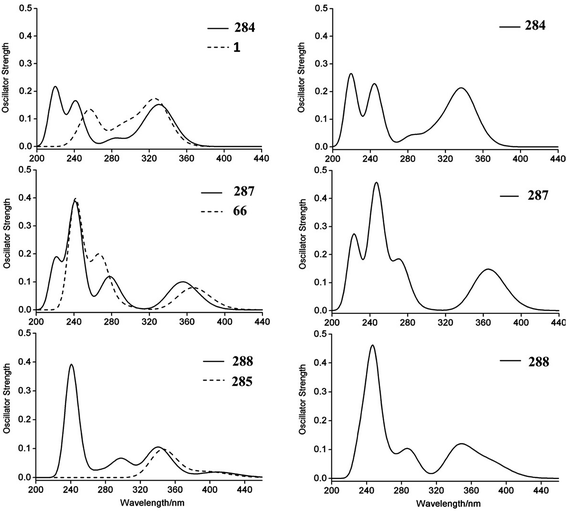 | ||
| Fig. 2 The simulated emission spectra of dibenzophospholes 1, 66, 284–285, 287–288, in vacuum (left) and in solution (THF, right)65 (reprinted with permission from the American Chemical Society). | ||
Based on the theoretical emission spectra, the dibenzophospholes 1, 66, 284–285, 287–288 may constitute deep blue light emitting materials in the range of λem = 327–419 nm. The Stokes shifts of 1 and 284 were calculated to about 45 nm, and the shifts of their derivatives 66, 285, 287 and 288 were all around 65 nm relative to carbazoles 292, the Stokes shifts of which were within 10 nm. The calculated emission spectra of dibenzophospholes 66, 285, 287 and 288 in vacuum, were red shifted and thio-modified dibenzophospholes 285 and 288 showed a small intramolecular charge-transfer emission at λ = 415 nm. The solvent effects led to larger Stokes shifts of dibenzophospholes 284, 287 and 288 in comparison to the carbazole analogues 292. For the compounds 284 and 287, THF stabilized their excited states, causing small red shifts (4–10 nm) of the emission spectra in comparison with those in vacuum. The opposite correlation was observed in the dibenzophosphole 288, where the solvent effects stabilized the ground state and induced the blue shift of the emission spectra. The radiative lifetimes were calculated by using Einstein transition probabilities for the compounds 1, 66, 284–285, 287 and 288. The dibenzophospholes 285 and 288 showed longer lifetimes than commonly used carbazoles 292, whereas the dibenzophospholes 1, 66, 284 and 287 had similar radiative lifetimes in comparison to the commonly used carbazoles 292.
In addition to this theoretical study, further investigations with thermogravimetric analysis (TGA) showed that the derivatives 66, 285 and 291 possess good thermal stabilities. This is important for the fabrication of OLEDs, because low-molecular weight species are often deposited as thin films by vacuum evaporation. The derivatives 66, 285 and 291 emitted in the UV region and were photoluminescent. The Stokes shifts of these compounds were relatively small (about 32–36 nm), which suggested a minimal rearrangement of molecules during photoexcitation. The quantum yields were dependent on the nature of the groups attached to the phosphorus atom. Selected photophysical, electrochemical and thermal data for these compounds are presented in Table 1.12
In 2011 the group of Anzenbacher Jr et al.66 investigated solid-state interactions, fluorescence and phosphorescence properties of dibenzophospholes 66, 228 and 285 as single crystals and the mixed crystals of 228 and 285 acquired in CH2Cl2/MeOH glass at 77 K. Moreover, an X-ray diffraction analysis was carried out, which indicated that the mixed crystal of 228 and 285 showed a larger number of intermolecular interactions such as π–π and Se–H, than each of them in the single crystals. The fluorescence maxima of the dibenzophospholes 66, 228, 285 in a glass corresponded to the wavelength at λ = 363–364 nm. However, in the compounds 228 and 285 the fluorescence was strongly suppressed due to the higher spin–orbit coupling of selenium 228 and sulfur 285. Additionally, these compounds exhibited comparable emission spectra with broad phosphorescence at λ = 450–660 nm. The phosphorescence lifetimes (τph) of the dibenzophospholes 66, 228 and 285 were τph = 312 ms, 0.54 ms and 21 ms, respectively. The emission and phosphorescence spectra of the single crystal of 66 were red-shifted compared to the spectrum reported in the glass, due to the intermolecular interactions in the solid state, however, the lifetime of 66 was shorter when compared to the glass. Similar red-shifts were observed for single crystals of 228 and 285, in the fluorescence and phosphorescence spectra. Furthermore, the mixed crystals of 228 and 285 exhibited only phosphorescence and presented carrier transport and emission properties. This advantage may be applied in the light-emitting single crystal organic field-effect transistors (SC-OFETs).66
Chi, Chou and Chang et al. obtained 5-[4-(carbazo-9-yl)phenyl]dibenzophosphole-5-oxide 212, which was used in the construction of the three-layer OLEDs as a bipolar host material.
This compound consisted of carbazole and dibenzophosphole moieties, which served as electron donor and acceptor, respectively. The carbazole derivatives are known as hole-transporting materials, with high triplet energy gap, which makes them efficient host materials for the phosphorescent dopants. Moreover, the phosphine oxide moiety facilitates the electron injection and transport without lowering of the triplet energy gap (Scheme 76).55
The selected electrochemical, thermal and photophysical characterisation of the dibenzophosphole 212 is presented in Table 2.
| Photophysical properties | Electrochemical properties | Thermal properties | ||||||
|---|---|---|---|---|---|---|---|---|
| λabs [nm] | λPh [nm] | λPL [nm] | Eox1/2 [V] | Ered1/2 [V] | HOMO [eV] | LUMO [eV] | Es [eV] | Td [°C] |
| a The oxidation and reduction experiments were conducted in CH2Cl2 and THF solution, E1/2 (V) refers to [(Epa + Epc)/2], where Epa and Epc were the anodic and cathodic peak potentials referenced to the Fc+/Fc couple, Es = |HOMO − LUMO| from the redox data. | ||||||||
| 292 | 425 | 458 | 0.98 | −2.33 | −5.78 | −2.33 | 3.55 | 365 |
Additionally, thermogravimetric analysis (TGA) of the dibenzophosphole 212, which decomposed at 365 °C, showed that this compound is capable of forming stable films upon thermal evaporation.
Other potential optoelectronic materials are dibenzophospholes 39 and 167. These compounds exhibited strong acceptor properties and showed enhanced two-photon absorptions at λ = 932 nm, therefore these compounds should be useful as long-wavelength emissive materials (Scheme 77).32
The absorption and emission maxima of the dibenzophospholes 39 and 167 showed bathochromic shifts compared with their silicon analogues 293 and 294, due to the strong acceptor properties of the phosphonium cores. The effect of solvents on optical properties in toluene, acetone and dichloromethane was also investigated for these compounds. The longest absorption wavelengths of the dibenzophospholes 39 and 167 were at λ = 460 and 495 nm, respectively in toluene and were almost the same as those in CH2Cl2. However, in acetone, the dibenzophospholes 39 and 167 exhibited blue-shifted absorption maxima at λ = 430 and 467 nm, respectively. The dibenzophosphole 39 exhibited higher fluorescence quantum yield, than its spirocyclic analog 167, which emitted much weaker fluorescence. The opposite trend was observed for the silicon compounds, in which spirocyclic framework of 293 improved the quantum yield. Another important difference was reported for fluorescence properties of dibenzophospholes and their silicon analogues. The emission bands of silicon derivatives 293 and 294 exhibited maxima at λ = 464 and 492 nm, while dibenzophospholes 39 and 167 were bathochromically shifted to λ = 647 and 715 nm, respectively, in CH2Cl2. The two-photon absorption (TPA) showed maxima for the silicon analogues 293 and 294 at λ = 752 and 775 nm, respectively. However, for the dibenzophospholes 39 and 167, the TPA maxima were in accordance with the bathochromic shifts and were red-shifted. Photophysical characterisation of the investigated compounds is summarized in Table 3.
| Compound | UV-Vis absorption | Fluorescence | Two photon absorption (TPA) | ||
|---|---|---|---|---|---|
| λmax [nm] | ε/105 M−1 [cm−1] | λem [nm] | ϕF | λmax2 [nm] | |
| a σ(2) divided by the molar mass (MW). | |||||
| 39 | 464 | 0.57 | 647 | 0.52 | 932 |
| 167 | 496 | 1.03 | 715 | 0.04 | 932 |
| 293 | 376 | 0.76 | 464 | 0.16 | 752 |
| 294 | 395 | 2.37 | 492 | 0.28 | 775 |
Optical data for the dibenzophospholes 157–161 and 164–166 compared with the dibenzophosphole 156, which does not contain the 2-alkoxyphenyl group, showed large red-shifts of absorption and emission maxima. The substituents on the phosphorus atom showed a small impact on the absorption and emission maxima in dibenzophospholes 157–159, which oscillated around at λ = 288 nm and 475 nm, for the absorption and emission maxima, respectively. The same effect was observed for substitutions at the 2- and 7-positions in dibenzophospholes 161 and 164. Compound 160 exhibited absorption maximum at a similar wavelength as 164, but the emission was less shifted. The farthest red-shifts for the absorption and emission maxima were observed for the dibenzophosphole 165 (Table 4 and Fig. 3).44
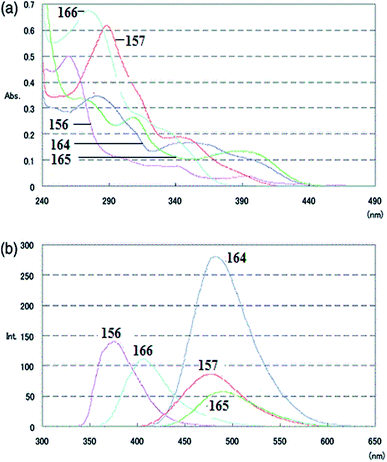 | ||
| Fig. 3 UV-Vis absorption and emission spectra of compounds 156–157 and 164–166, in CHCl3 (10−5M)44 (reprinted with permission from the American Chemical Society). | ||
The absorption and emission spectra of the derivatives 203–205 were slightly red-shifted in comparison to the dibenzophosphole 202. The photoluminescence spectra of all investigated compounds 202–205 showed maxima between λem = 365 to 432 nm. These values were in the ultraviolet to violet range and corresponded to blue light emission, for the solution and solid states. The quantum yields of dilute solutions varied significantly with the nature of the 3,7-substituents. The highest value was observed for the derivative 205. The optical properties of these compounds are presented in Table 5 and Fig. 4.52
| Compound | UV-Vis absorption | Photoluminescence | |||
|---|---|---|---|---|---|
| λabs [nm] | log![[thin space (1/6-em)]](https://www.rsc.org/images/entities/char_2009.gif) ε ε |
λem [nm] solution | ϕPL solution | λem [nm] solid | |
| a Referenced to 1,4-bis-(5-phenyl-2-oxazolyl)benzene (POPOP) in THF (ϕF = 0.97).b Referenced to 9,10-diphenylanthracene in THF (ϕF = 0.9). | |||||
| 202 | 325 | 3.6 | 365 | 0.18a | 378 |
| 203 | 338 | 3.8 | 395 | 0.60a | 428 |
| 204 | 385 | — | 424 | 0.54b | — |
| 369 | 443 | ||||
| 205 | 380 | 3.7 | 414 | 0.98b | 472 |
| 432 | |||||
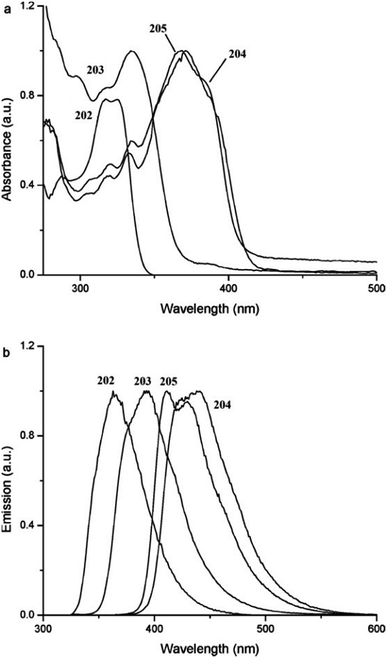 | ||
| Fig. 4 UV-Vis absorption (a) and emission (b) spectra of the compounds 202–205 in THF52 (reprinted with permission from the American Chemical Society). | ||
Tilley et al. investigated electrochemical properties of dibenzophospholes 202–205. Selected results are summarized in Table 6.
The 3,7-thienyl and alkynyl disubstituted derivatives 204 and 205 exhibited a decrease of LUMO values by 0.1–0.3 eV compared to the dibenzophosphole 202, due to their slightly longer conjugation length. Additionally, the thienyl dibenzophosphole 204 exhibited higher HOMO energy level, than the alkynyl derivative 205. The derivative 203 had the widest range of the energy gap. The low values of LUMO levels in dibenzophospholes 202–205, suggested that these compounds could be useful as n-type conducting materials.52
4.2. Fused dibenzophospholes
The dibenzophosphole oxide 129 showed absorption maximum at λabs = 340 nm and emission at λem = 382 nm, for the CH2Cl2 solution. The absorption and emission maxima of the dibenzophospholes 131-anti and 133-syn were red-shifted compared to the derivative 129 related to π-expansion through the σ*–π* conjugation of the π-framework to the σ* orbital of the exocyclic P–C bonds. The dibenzophosphole oxides 131-anti and 133-syn exhibited high fluorescence quantum yields of 0.89 and 0.79, in solution. In the solid state, the quantum yields of both compounds were somewhat lower. In this state, the quantum yield of 133-syn (ϕF = 0.63) was larger than that of 131-anti (ϕF = 0.46), indicating that interactions in the solid state were different for both diastereomers due to conformational difference.
The dibenzophosphole sulfides 220-anti and 221-syn revealed different photophysical properties compared with the dibenzophosphole oxides 131-anti and 133-syn. The absorption maxima of the sulfides had almost the same values of λabs = 385 nm (log![[thin space (1/6-em)]](https://www.rsc.org/images/entities/char_2009.gif) ε = 3.73) and λabs = 386 nm (log
ε = 3.73) and λabs = 386 nm (log![[thin space (1/6-em)]](https://www.rsc.org/images/entities/char_2009.gif) ε = 3.72) for 220-anti and 221-syn, respectively. These electronic properties led to blue-shifted absorption maxima of the dibenzophospholes sulfides in comparison with those of the dibenzophosphole oxides. The fluorescence quantum yields of the sulfides 220-anti and 221-syn, in solution dramatically dropped down to 0.004 in comparison to oxides 131-anti and 133-syn, but in the solid state increased to 0.12 and 0.04 for 220-anti and 221-syn, respectively. The selected photophysical properties of the investigated compounds are summarized in Table 7.40
ε = 3.72) for 220-anti and 221-syn, respectively. These electronic properties led to blue-shifted absorption maxima of the dibenzophospholes sulfides in comparison with those of the dibenzophosphole oxides. The fluorescence quantum yields of the sulfides 220-anti and 221-syn, in solution dramatically dropped down to 0.004 in comparison to oxides 131-anti and 133-syn, but in the solid state increased to 0.12 and 0.04 for 220-anti and 221-syn, respectively. The selected photophysical properties of the investigated compounds are summarized in Table 7.40
| Compound | UV-Vis absorption | Fluorescence | ||||
|---|---|---|---|---|---|---|
| λabs [nm] | log![[thin space (1/6-em)]](https://www.rsc.org/images/entities/char_2009.gif) ε ε |
λem [nm] solution | ϕFa solution | λem [nm] solid | ϕFa solid | |
| a Absolute quantum yield determined by an integrating sphere system. | ||||||
| 129 | 340 | 3.19 | 382 | 0.67 | — | — |
| 131-anti | 391 | 3.68 | 426, 438 | 0.89 | 454 | 0.46 |
| 133-syn | 391 | 3.61 | 426, 438 | 0.79 | 476 | 0.63 |
| 220-anti | 385 | 3.73 | 430 | 0.004 | 437, 471, 501 | 0.12 |
| 221-syn | 386 | 3.72 | 431 | 0.004 | 476, 500 | 0.04 |
The linearly fused dibenzophospholes 195 and 196 are also promising for optoelectronics devices, in which optical properties were highly dependent on the combination of benzo[b](thiophene or pyrrole) subunits (Scheme 81).50
The UV-Vis absorption and emission spectra of the dibenzophospholes 195 and 196 were significantly blue shifted relative to the corresponding non-fused biaryl substrates 193 (see subsection 2.11). The Stokes shifts of the rigid fused structures of 195 (3829 cm−1) and 196 (4810 cm−1) were smaller than those of the biaryl substrates 193 (R = S) (4250 cm−1) and 193 (R = NMe) (7000 cm−1).
Density functional theory (DFT) calculations at the B3LYP/6-31G* level showed widening of the HOMO–LUMO gap upon acetylene fusion. The energy gaps were changed from 3.53/3.34 eV for 193 (R = S, NMe) to 4.10/3.85 eV, for 195 and 196, respectively.
The fluorescence decay curves of the compounds 195 and 196 in CH2Cl2 were fitted as a single exponential with lifetimes of 2.2 and 7.9 ns. More photophysical properties of 195 and 196 including quantum yields are displayed in Table 8.50
The dibenzophospholes 186 and 187 compared to the respective nonfused precursors 185 (Y = S, O) showed blue-shift absorption maxima, higher oxidation and lower reduction potential values, which indicated the less efficient electron π-delocalization over the sp2-C atoms of 186 and 187 and typical for the dibenzophospholes, increased localization of the π-electrons within aromatic subunits. Although, the dibenzophospholes 186 and 187 were emissive materials with λmax = 475 and 477 nm, respectively, their quantum yields oscillated at around 1%. Photophysical properties of these compounds are presented in Table 9.48
| Compound | UV-Vis absorption | Fluorescence | |
|---|---|---|---|
| λmax [nm] | log![[thin space (1/6-em)]](https://www.rsc.org/images/entities/char_2009.gif) ε ε |
λem [nm] | |
| 185 (Y = S) | 413 | 3.48 | 484 |
| 185 (Y = O) | 411 | 3.83 | — |
| 186 | 391 | 3.56 | 475 |
| 187 | 389 | 3.63 | 477 |
The optical and electrochemical properties of these dibenzophospholes were investigated to evaluate the impact of the P modifications on their electronic properties. The absorption spectra of the all investigated fused dibenzophospholes 190–192, 209, 235 and 263 varied over a wide range covering the entire visible spectrum. In the absorption spectrum of the dibenzophosphole 192, an intense characteristic band at λmax = 472 nm was observed. The absorption maxima of the σ4-P derivatives 190, 209 and 235 were shifted towards higher wavelengths. A larger bathochromic shift was observed for P-alkyl and P-S phospholium salts 263 and 191. Addition of a phenyl group to phosphorus in the dibenzophosphole 192 resulted in a shift of its maximum absorption towards higher wavelengths. All of these dibenzophospholes were fluorescent in solution, with gradual red shifts of the λem in the compounds 190–192 and 263. The Stokes shifts for rigid structures in the compounds 192, 190, and 263 were relatively small (737, 1072, 1355 cm−1, respectively). Furthermore, the emission bands indicated a small rearrangement of these molecules upon photoexcitation and for this reason their quantum yields were relatively high (>0.20), as opposed to the derivative 191, which presented a larger Stokes shift (2875 cm−1) accompanied by a decrease in the fluorescence quantum yield to 0.03.
Cyclic voltammetry measurements of these compounds showed that the chemical functionalisation of the P center in the dibenzophospholes 190–192 and 263 led to a gradual increase in the oxidation and reduction potentials as well as indicated that the phospholium salts 191 and 263 had high electron affinities. Moreover, the dibenzophospholes 190, 209, 235 and 263 presented reversible reduction waves, which suggested stability in their reduced state, under the measurement conditions. It is noteworthy that the evolution of the redox potentials within the compounds 190–192 and 263 were consistent with the decrease in the optical gap. Accurate photophysical and electrochemical data of these compounds are presented in Table 10 and Fig. 5.49
![[thin space (1/6-em)]](https://www.rsc.org/images/entities/char_2009.gif) ε), wavelength of emission maxima (λem), fluorescence quantum yields (ϕF), oxidation potentials (Eox1), reduction potentials (Ered1)
ε), wavelength of emission maxima (λem), fluorescence quantum yields (ϕF), oxidation potentials (Eox1), reduction potentials (Ered1)
| Compound | UV-Vis absorption | Fluorescence | Redox potentials | |||
|---|---|---|---|---|---|---|
| λabsa [nm] | log![[thin space (1/6-em)]](https://www.rsc.org/images/entities/char_2009.gif) εa εa |
λema [nm] | ϕF a,b | Eox1b | Ered1c | |
| a In dichloromethane (10−5 M).b Measured relative to fluorescein (NaOH, 0.1 M, ϕF = 0.9).c In dichloromethane and Bu4N+PF6− (0.2 M).d Reversible process. | ||||||
| 190 | 514 | 4.04 | 544 | 0.21 | 0.71 | −1.70 |
| 191 | 569 | 3.95 | 669 | 0.03 | 1.01 | −1.04d |
| 192 | 472 | 4.34 | 489 | 0.80 | 0.44 | −2.10d |
| 209 | 524 | 4.11 | 549 | 0.52 | 0.77 | −1.71d |
| 235 | 508 | 4.14 | 537 | 0.08 | 0.75 | −1.67d |
| 263 | 554 | 4.00 | 599 | 0.19 | 0.97 | −1.31d |
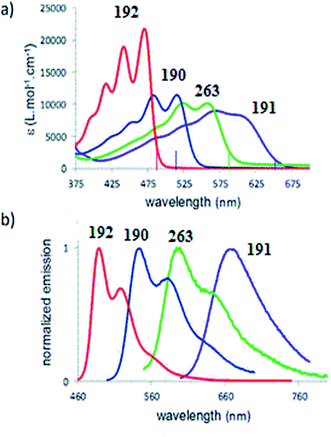 | ||
| Fig. 5 UV-Vis absorption spectra (a), normalised emission spectra (b) of the compounds 190–192 and 263 in dichloromethane (10−5 M)49 (reprinted with permission from the American Chemical Society). | ||
Time-dependent density functional theory (TD-DFT) calculations were performed to gain more insight into the electronic properties of the dibenzophospholes 190–192, 209, 235 and 263. These results showed that the long-wavelength UV-Vis absorption of these dibenzophospholes resulted from HOMO–LUMO transitions. The frontier molecular orbitals were comparable in 190–192, 209 and 263. These π molecular orbitals were delocalized on the sp2-carbon skeletons with a contribution of the respective orbitals of the phosphole ring.
The HOMO with a nodal plane on the PIII was influenced by the inductive effects of the substituents on the phosphorus atom. Additionally, both experimental and theoretical data showed that the local chemical modifications around P had a great significance on the gap fine-tuning.49
The UV-Vis absorption spectra of the dibenzophospholes 17-cis and 18-trans showed an absorption band with the maxima wavelength at λabs = 347 nm and logarithms of the molar absorption coefficient 2.52 and 2.56 for 17-cis and 18-trans, respectively. Additionally, both isomers presented essentially identical spectra irrespective of the stereochemistry. The fluorescence spectra of 17-cis and 18-trans showed a violet fluorescence with the maximum wavelength at λem = 387 nm in both cases, whereas the quantum yield was low (ϕF = 0.03).
Notably, the absorption and fluorescence spectra of 17-cis and 18-trans were in the longer wavelength range, than those of the dibenzophosphole oxide 66. These results were attributable to the small HOMO–LUMO gap of isomers 17-cis and 18-trans. The compounds 20-trans and 21-trans showed absorption at λabs = 375 and 399 nm, and fluorescence bands at λem = 422 and 547 nm, respectively, which were related to the effective extension of π conjugation. Whereas the dibenzophospholes 17-cis and 18-trans showed only a faint fluorescence, the π-extended derivatives 20-trans and 21-trans presented more intense emission with ϕF values of 0.20 and 0.34, respectively. Remarkably, the λem value of the dibenzophosphole 21-trans was longer than that of compound 20-trans in CHCl3. To compare the electron-accepting properties of the bridged compounds 20-trans and 21-trans, the non-bridged dibenzophosphole 273 was also prepared and measured in various solvents. For the compounds 21-trans and 273, the fluorescence spectra presented considerable bathochromic shifts with increasing polarity of a solvent, whereas the absorption maxima showed small solvent dependence. These facts demonstrate that the compounds 21-trans and 273 had more polar structures in the excited state than in the ground state. The use of the Lippert–Mataga equation to compare the degree of polarity of the structures in the excited state, showed that extension of the electron-accepting character of the bridged dibenzophospholes 20 and 21-trans was larger than the non-bridged dibenzophosphole analogue 273. Noteworthy is that the dibenzophosphole 21-trans retained fluorescence quantum yield in the solid state of ϕF = 0.30, in contrast to the non-bridged analogue 273 which exhibited a much smaller fluorescence quantum yield than in solution (ϕF = 0.18 for solid, 0.89 for solution). Individual results of the investigated compounds are summarized in Table 11.27
| Compound | UV-Vis absorption | Fluorescence | ||
|---|---|---|---|---|
| λabsa [nm] | log![[thin space (1/6-em)]](https://www.rsc.org/images/entities/char_2009.gif) ε ε |
λemb [nm] | ϕFc | |
| a Only absorption maxima at the longest wavelengths were shown.b Emission maxima upon excitation at the absorption maximum wavelengths.c Absolute fluorescence quantum yields determined by a calibrated integrating sphere system within ±3% errors. | ||||
| 17-cis | 347 | 2.52 | 387 | 0.03 |
| 18-trans | 347 | 2.56 | 387 | 0.03 |
| 20-trans | 375 | 3.54 | 422 | 0.20 |
| 21-trans | 399 | 4.57 | 547 | 0.34 (0.30) |
| 66 | 332 | 2.89 | 366 | 0.042 |
| 273 | 396 | 4.63 | 499 | 0.89 (0.18) |
Yamaguchi and Studer et al. presented the cyclic voltammograms of the dibenzophospholes 21-trans and 273, showing the first reversible reduction waves with reduction potentials of −2.15 and −2.36 V, respectively. These observations indicated that the dibenzophosphole 21-trans might serve as a material to enhance the electron-accepting character.
5. Application of dibenzophospholes for organic electronic devices
We believe that dibenzophospholes, as organic π-conjugated compounds, have enormous potential as optoelectronic materials for example in light-emitting diodes, organic field-effect transistors, nonlinear optical devices and organic solar cells.39 However, in the years 2001–2016, only limited testing of dibenzophospholes and their derivatives as materials in these types of device took place. In the 15 years since the review by Aitken11 in 2001, only two simple dibenzophospholes 66 and 212 were used in Organic Light-Emitting Diodes (OLEDs) in various configurations. These devices were fabricated in typical layered structures on indium-tin-oxide (ITO)-coated glass substrates (≤15 Ω) with multiple organic layers between the transparent bottom ITO anode and the top metal cathode. The organic and metal layers were deposited by thermal evaporation under high vacuum conditions with a base pressure of <10−6 Torr. The active areas of the devices were 2 × 2 mm2 as defined by the shadow mask for cathode deposition.Chi, Chou and Chang et al. applied the dibenzophosphole 212 in the three layer OLEDs with 4 wt% of Os complex as an emitter. The dibenzophosphole 212 served as a bipolar host material with electron-donor properties due to the carbazole moiety, as well as electron-acceptor properties by reason of the presence of phosphoryl moiety. The configurations of these devices were as follows: ITO/3DTAPBP-[2,2′-bis(3-(N,N-di-p-tolylamino)phenyl)biphenyl] (40 nm)/the dibenzophosphole 212 with Os complexes A or B (Scheme 85) (30 nm)/BP4mPy-[3,3′,5,5′-tetra[(3-pyridyl)-phen-3-yl]biphenyl (40 nm)]/LiF (0.8 nm)/Al (150 nm) (Fig. 6).55
3DTAPBP with a wide triplet gap of around 2.68 eV, was employed as the hole-transport or a host material in red-emitting OLEDs. The second material BP4mPY served as an electron transport layer. These devices exhibited a bright emission of dopants due to good transfer energy between the host and guest materials. Below are presented the Os(II) complexes used in these red-emitting OLEDs (Scheme 85).
The efficiencies of OLEDs in this configuration were as follows: cf. 14.3%, 34.8 cd A−1 and 45.2 lm W−1 for the complex A and 9.9%, 15.7 cd A−1 and 20.5 lm W−1 for the complex B. The luminance maxima of 52.6 and 23.7 cd m−2 were achieved for the complexes A and B, through applying relatively low voltages of 2.5 and 2.6 V, respectively. Moreover, the internal quantum efficiency amounted to nearly 100% in both devices.
The resulting device parameters for the phosphorescent OLED containing as host dibenzophosphole 212 can be compared to the parameters of an OLED containing the standard bipolar host material CBP-4,4′-N,N′-dicarbazolebiphenyl in the following configuration: ITO/3DTAPBP (40 nm)/CBP (or dibenzophosphole 212) doped with 4% Os complexes A, B (30 nm)/BP4mPy (40 nm)/LiF (0.8 nm)/Al (150 nm) or with other commercial materials, such as BP4mPy/3DTAPBP in the following configurations: ITO/3DTAPBP (40 nm)/3DTAPBP doped with 4% Os complexes A, B (10 nm)/BP4mPy doped with 4% of Os complexes A, B (20 nm)/BP4mPy (40 nm)/LiF (0.8 nm)/Al (150 nm).
The parameters obtained for the standard host material (CBP, BP4mPy/3DTAPBP) doped with Os complexes A and B were lower than those obtained for the host dibenzophosphole 212 doped with the Os complex A (14.3%, 34.8 cd A−1 and 45.2 lm W−1): for CBP, efficiencies of 10.9% (21.7 cd A−1 and 11.9 lm W−1) and 10.1% (13.7 cd A−1 and 10.0 lm W−1) for the Os complexes A and B were achieved, respectively, whereas, efficiencies for the devices with BP4mPy/3DTAPBP in the second configuration of 12.9% (27.9 cd A−1 and 21.8 lm W−1) for the complex A and 10.7% (18.5 cd A−1 and 19.3 lm W−1) for the complex B, were obtained.55
The compound 212 was also used in the only-hole device in the following configuration: ITO/MoO3 (1 nm)/TAPC-[di-[4-(N,N-ditholylamino)-phenyl]cyclohexane] (30 nm)/TCTA-[4,4′,4′′-tris(carbazol-9-yl)-triphenylamine] (30 nm)/the compound 212 (100 nm)/MoO3 (20 nm)/Al (110 nm), for which MoO3 was applied as a hole injection/electron blocking layer, while TAPC and TCTA were used as dual hole-transport layers for providing a smooth hole-injection into the tested material as shown in Fig. 7.55
Analogously, an only-electron device was also prepared in the following configuration: ITO/Al(20 nm)/the dibenzophospholes 212 (100 nm)/TmPyPB-[1,3,5-tri[(3-pyridyl)-phen-3-yl]benzene] (10 nm)/TmPyPB doped with 10 wt% of n-type cesium carbonate Cs2CO3 (10 nm)/Al (110 nm), where TmPyPB was used as the electron transport layer.
Current density–voltage (J–V) characteristics of the only-hole and only-electron devices exhibited the excellent hole and electron transport capability of the dibenzophosphole 212. Summarizing, the dibenzophosphole 212 possesses superior carrier transport properties for both positive and negative charges.
In contrast, the dibenzophosphole 66, which was used in 2006 by Wu and Réau et al. as an electron transport layer, hole transport layer as well as an ambipolar material for OLEDs, turned out to be an unsuitable component for single- and two-layer OLEDs. The configuration of the single-layer OLED used was the following: ITO/PEDOT:PSS (poly(3,4-ethylenedioxythiophene):polystyrene sulfonate) (25 nm)/organic layer (100 nm)/Mg:Ag (80 nm)/Ag (150 nm) as shown in Fig. 8.12
Light emission was observed for a turn-on voltage of 4 V. However, the device was unstable and its electroluminescence characteristics (brightness, emission wavelength) varied rapidly with applied driving current.
The dibenzophosphole 66 was also tested in the two-layer OLEDs as an electron-transporting material (n-type) as well as hole-transporting material (p-type) in the two following configurations: ITO/PEDOT/TCT-[tris(4-carbazoyl-9-ylphenyl)amine]/the compound 66/Mg:Ag/Ag and ITO/PEDOT/dibenzophosphole 66/TPBI-[2,2′,2′′-(1,3,5-benzinetriyl)-tris(1-phenyl-1H-benzimidazole)]/Mg:Ag/Ag. Thus, the compound 66 was mixed with the known p-type hole-transporting material TCTA-[tris(4-carbazoyl-9-ylphenyl)amine and with the commonly known n-type electron transporting material TPBI-[2,2′,2′′-(1,3,5-benzenetriyl)-tris(1-phenyl-1H-benzimidazole)] to provide two unstable bulk-hetero junctions, respectively (Fig. 9).12 A comparison of the opposite results obtained with dibenzophospholes 66 and 212 as materials for OLEDs, shows that more intensive investigations should be undertaken in this area with other representatives of dibenzophospholes, as reviewed in this article.
6. Conclusions
Dibenzophosphole and its derivatives are an underestimated group of heterorganic compounds which may serve as electroluminescent materials for optoelectronic devices due to easy synthesis (subsection 2) and functionalization (subsection 3), high thermal stability and the possibility of fine-tuning their electronic properties through various structural modifications both on phosphorus and the benzene rings (subsections 3.1 and 3.2). Other areas of optoelectronics are open for exploration of dibenzophospholes and their derivatives. The 31P-NMR technique may be a very useful tool for the rapid monitoring of progress in chemical synthesis and in testing chemical purity and stability of these compounds. Since, so far, only two dibenzophospholes 66 and 212 were used in construction of emitting diodes,12,65 more intensive research with other dibenzophosphole representatives should certainly be investigated in the future.This review shows the great potential of both simple and functionalized dibenzophospholes that should be tested more intensely as single materials, as well as in structural combinations with other π-extended conjugated aromatic and heteroaromatic systems containing phosphorus, nitrogen, silicon or sulfur atoms. The promising results obtained so far with closely related phospholes12 may outline possible directions of further improvements in optoelectronic materials based on organophosphorus compounds.
Acknowledgements
This work was financed by the National Science Centre (NCN), Poland on the basis of the grant number 2013/11/B/ST5/01610 and by Statutory Funds from the Ministry of Science and Higher Education in Poland.References
- H. Shirakawa, E. J. Louis, A. MacDiarmid, C. Chiang and A. J. Heeger, J. Chem. Soc., Chem. Commun., 1977, 16, 578 RSC.
- U. Mitschke and P. Bauerle, J. Mater. Chem., 2000, 10, 1471 RSC.
- M. J. S. Dewar and N. Trinajstic, J. Am. Chem. Soc., 1970, 92, 1453 CrossRef CAS.
- B. El Hamaoui, L. Zhi, J. Wu, J. Li, N. T. Lucas, Z. Tomovic, U. Kolb and K. Mllen, Adv. Funct. Mater., 2007, 17, 1179 CrossRef CAS.
- T. Baumgartner and R. Reau, Chem. Rev., 2006, 106, 4681 CrossRef CAS PubMed.
- M. G. Hobbs and T. Baumgartner, Eur. J. Inorg. Chem., 2007, 23, 3611 CrossRef.
- T. Baumgartner, Acc. Chem. Res., 2014, 47, 1613 CrossRef CAS PubMed.
- D. Joly, P.-A. Bouit and M. Hissler, J. Mater. Chem. C, 2016, 4, 3686 RSC.
- M. P. Duffy, W. Delaunay, P.-A. Bouit and M. Hissler, Chem. Soc. Rev., 2016, 45, 5296 RSC.
- K. Fourmy, D. Nguyen, O. Cabaret and M. Gouygou, Catal. Sci. Technol., 2015, 5, 4289 CAS.
- R. A. Aitken, Sci. Synth., 2001, 10, 817 CAS.
- H. Su, O. Fadhel, C. Yang, T. Cho, C. Fave, M. Hissler, C. Wu and R. Réau, J. Am. Chem. Soc., 2006, 128, 983 CrossRef CAS PubMed.
- T. Baumgartner, T. Neumann and B. Wirges, Angew. Chem., Int. Ed., 2004, 43, 6197 CrossRef CAS PubMed.
- T. Baumgartner, W. Bergmans, T. Karpati, T. Neumann, M. Nieger and L. Nyulászi, Chem.–Eur. J., 2005, 11, 4687 CrossRef CAS PubMed.
- S. Durben, Y. Dienes and T. Baumgartner, Org. Lett., 2006, 8, 5893 CrossRef CAS PubMed.
- Y. Dienes, S. Durben, T. Karpati, T. Neumann, U. Englert, L. Nyulászi and T. Baumgartner, Chem.–Eur. J., 2007, 13, 7487 CrossRef CAS PubMed.
- Y. Matano and H. Imahori, Org. Biomol. Chem., 2009, 7, 1258 CAS.
- C. Romero-Nieto and T. Baumgartner, Synlett, 2013, 24, 920 CrossRef CAS.
- G. Wittig and G. Geissler, Justus Liebigs Ann. Chem., 1953, 44, 580 Search PubMed.
- S. Ogawa, Y. Tajiri and N. Furukawa, Bull. Chem. Soc. Jpn., 1991, 64, 3182 CrossRef CAS.
- G. Wittig and A. Maercker, Chem. Ber., 1964, 97, 747 CrossRef CAS.
- S. Affandi, R. L. Green, B. T. Hsieh, M. S. Holt, J. H. Nelson and E. C. Alyea, Synth. React. Inorg. Met.-Org. Chem., 1987, 17, 307 CrossRef CAS.
- G. Wittig and E. Kochendoerfer, Chem. Ber., 1964, 97, 741 CrossRef CAS.
- G. Wittig and E. Benz, Chem. Ber., 1959, 92, 1999 CrossRef CAS.
- D. Hellwinkel, Chem. Ber., 1966, 99, 3642 CrossRef CAS.
- O. Herd, D. Hoff, K. W. Kottsieper, C. Liek, K. Wenz, O. Stelzer and W. S. Sheldrick, Inorg. Chem., 2002, 41(20), 5034 CrossRef CAS PubMed.
- A. Bruch, A. Fukazawa, E. Yamaguchi, S. Yamaguchi and A. Studer, Angew. Chem., Int. Ed., 2011, 50, 12094 CrossRef CAS PubMed.
- Q. Ruan, L. Zhou and B. Breit, Catal. Commun., 2014, 53, 87 CrossRef CAS.
- J. A. Macor, J. L. Brown, J. N. Cross, S. R. Daly, A. J. Gaunt, G. S. Girolami, M. T. Janicke, S. A. Kozimor, M. P. Neu, A. C. Olson, S. D. Reilly and B. L. Scott, Dalton Trans., 2015, 44, 18923 RSC.
- H. Kalkeren, S. Leenders, C. Hommersom, F. Rutjes and F. Delft, Chem.–Eur. J., 2011, 17, 11290 CrossRef PubMed.
- A. Oukhrib, L. Bonnafoux, A. Panossian, S. Waifang, D. H. Nguyen, M. Urrutigoity, F. Colobert, M. Gouygou and F. R. Leroux, Tetrahedron, 2014, 70, 1431 CrossRef CAS.
- T. Agou, M. D. Hossain, T. Kawashima, K. Kamada and K. Ohta, Chem. Commun., 2009, 44, 6762 RSC.
- K. Yavari, P. Retailleau, A. Voituriez and A. Marinetti, Chem.–Eur. J., 2013, 19, 9939 CrossRef CAS PubMed.
- A. S. Ionkin and W. J. Marshall, Heteroat. Chem., 2003, 14(4), 360 CrossRef CAS.
- A. A. Diaz, J. D. Young, M. A. Khan and R. J. Wehmschulte, Inorg. Chem., 2006, 45, 5568 CrossRef CAS PubMed.
- V. Diemer, A. Berthelot, J. Bayardon, S. Juge, F. R. Leroux and F. Colobert, J. Org. Chem., 2012, 77, 6117 CrossRef CAS PubMed.
- K. Baba, M. Tobisu and N. Chatani, Angew. Chem., Int. Ed., 2013, 52, 11892 CrossRef CAS PubMed.
- Y. Unoh, T. Satoh, K. Hirano and M. Miura, ACS Catal., 2015, 5, 6634 CrossRef CAS.
- Y. Kuninobu, T. Yoshida and K. Takai, J. Org. Chem., 2011, 76, 7370 CrossRef CAS PubMed.
- S. Furukawa, S. Haga, J. Kobayashi and T. Kawashima, Org. Lett., 2014, 16, 3228 CrossRef CAS PubMed.
- Y. Cui, L. Fu, J. Cao, Y. Deng and J. Jiang, Adv. Synth. Catal., 2014, 356, 1217 CrossRef CAS.
- S. Ishikawa and K. Manabe, Tetrahedron, 2010, 66, 297 CrossRef CAS.
- M. Stankevič, J. Pisklak and K. Włodarczyk, Tetrahedron, 2016, 72, 810 CrossRef.
- N. Fukawa, T. Osaka, K. Noguchi and K. Tanaka, Org. Lett., 2010, 12(6), 1324 CrossRef CAS PubMed.
- E. Martinez-Arripe, F. Jean-Baptiste-dit-Dominique, A. Auffrant, X. F. Le Goff, J. Thuilliez and F. Nief, Organometallics, 2012, 31, 4854 CrossRef CAS.
- S. Shah, M. Cather Simpson, R. C. Smith and J. D. Protasiewicz, J. Am. Chem. Soc., 2001, 123, 6925 CrossRef CAS PubMed.
- X. Wei, Z. Lu, X. Zhao, Z. Duan and F. Mathey, Angew. Chem., Int. Ed., 2015, 54, 1583–1586 CrossRef CAS PubMed.
- O. Fadhel, D. Szieberth, V. Deborde, C. Lescop, L. Nyulászi, M. Hissler and R. Réau, Chem.–Eur. J., 2009, 15, 4914 CrossRef CAS PubMed.
- P. Bouit, A. Escande, R. Szucs, D. Szieberth, C. Lescop, L. Nyulászi, M. Hissler and R. Réau, J. Am. Chem. Soc., 2012, 134, 6524 CrossRef CAS PubMed.
- Y. Hayashi, Y. Matano, K. Suda, Y. Kimura, Y. Nakao and H. Imahori, Chem.–Eur. J., 2012, 18, 15972 CrossRef CAS PubMed.
- H. Kalkeren, S. Leenders, C. Hommersom, F. Rutjes and F. Delft, Chem.–Eur. J., 2011, 17, 11290 CrossRef PubMed.
- K. Geramita, J. McBee and T. D. Tilley, J. Org. Chem., 2009, 74, 820 CrossRef CAS PubMed.
- Y. J. Ahn, R. J. Rubio, T. K. Hollis, F. S. Tham and B. Donnadeiu, Organometallics, 2006, 25, 1079 CrossRef CAS.
- N. Dubrovina, H. Jiao, V. Tararov, A. Spannenberg, R. Kadyrov, A. Monsees, A. Christiansen and A. Borner, Eur. J. Org. Chem., 2006, 11, 3412 CrossRef.
- C. H. Lin, C. W. H. Su, J. L. Liao, Y. M. Cheng, Y. Chi, T. Y. Lin, M. W. Chung, P. T. Chou, G. H. Lee, C. H. Chang, C. Y. Shih and C. L. Ho, J. Mater. Chem., 2012, 22, 10684 RSC.
- H. A. van Kalkeren, C. Grotenhuis, F. S. Haasjes, C. A. Hommersom, F. P. J. T. Rutjes and F. L. van Delft, Eur. J. Org. Chem., 2013, 31, 7059 CrossRef.
- H. A. Kalkeren, J. J. Bruins, F. P. J. T. Rutjes and F. L. Delft, Adv. Synth. Catal., 2012, 354, 1417 CrossRef.
- E. Durán, E. Gordo, J. Granell, M. Font-Bardía, X. Solans, D. Velasco and F. López-Calahorra, Tetrahedron: Asymmetry, 2001, 12, 1987 CrossRef.
- J. G. L. Cortés, S. Vincendeau, J. C. Daran, E. Manoury and M. Gouygou, Acta Crystallogr., Sect. C: Cryst. Struct. Commun., 2006, 62, m188 Search PubMed.
- A. Decken, M. Neil, C. Dyker and F. Bottomley, Can. J. Chem., 2002, 80, 55 CrossRef CAS.
- A. Decken, M. Neil, C. Dyker and F. Bottomley, Can. J. Chem., 2001, 79, 1321 CrossRef CAS.
- D. H. Nguyen, H. Lauréano, S. Jugé, P. Kalck, J. C. Daran, Y. Coppel, M. Urrutigoity and M. Gouygou, Organometallics, 2009, 28, 6288 CrossRef CAS.
- C. Thoumazet, L. Ricard, H. Gruützmacherb and P. Le Floch, Chem. Commun., 2005, 12, 1592 RSC.
- E. Duran, D. Valasco, F. Lopez-Calahorra and H. Finkelmann, Mol. Cryst. Liq. Cryst., 2010, 381, 43 CrossRef.
- J. Yin, R. F. Chen, S. L. Zhang, Q. D. Ling and W. Huang, J. Phys. Chem. A, 2010, 114, 3655 CrossRef CAS PubMed.
- R. Kabe, V. M. Lynch and P. Anzenbacher, CrystEngComm, 2011, 13, 5423 RSC.
| This journal is © The Royal Society of Chemistry 2017 |


